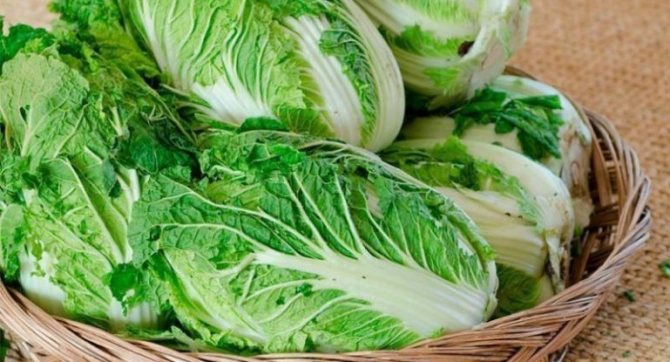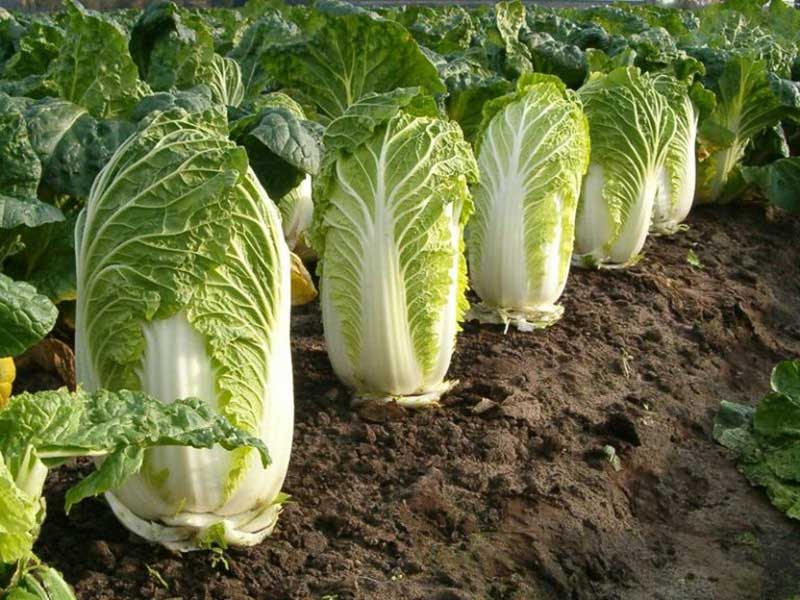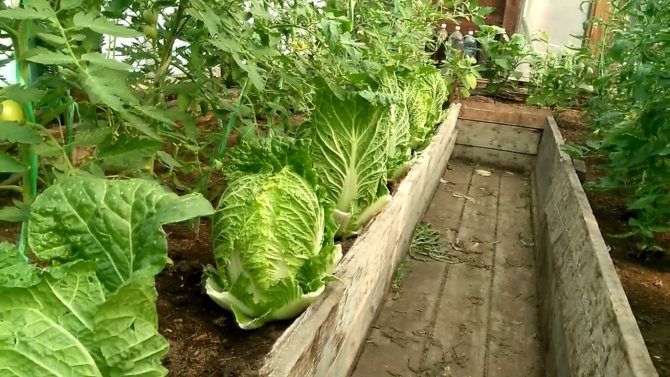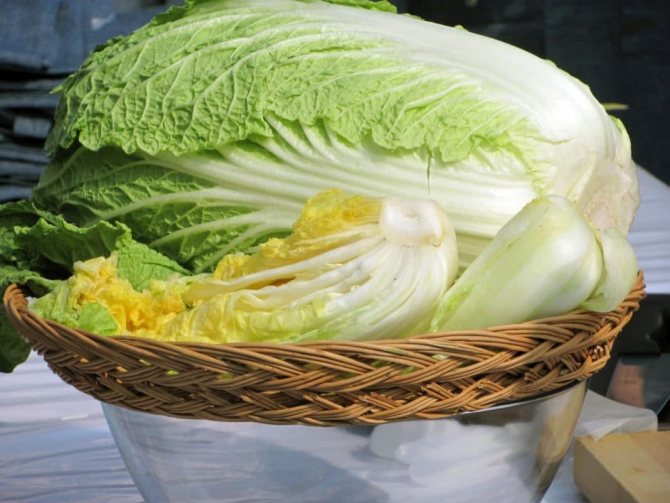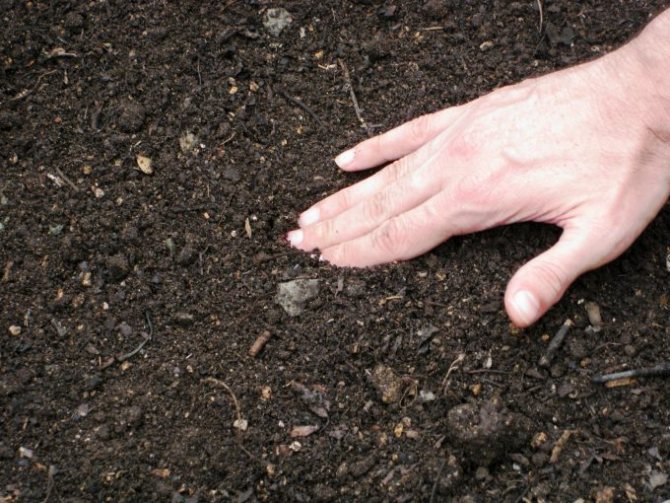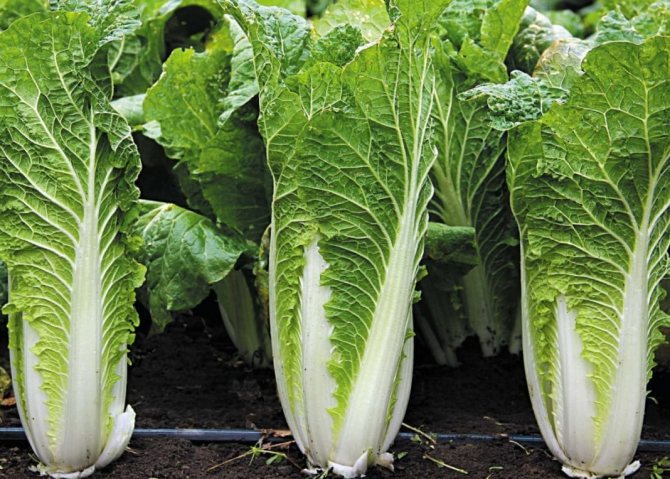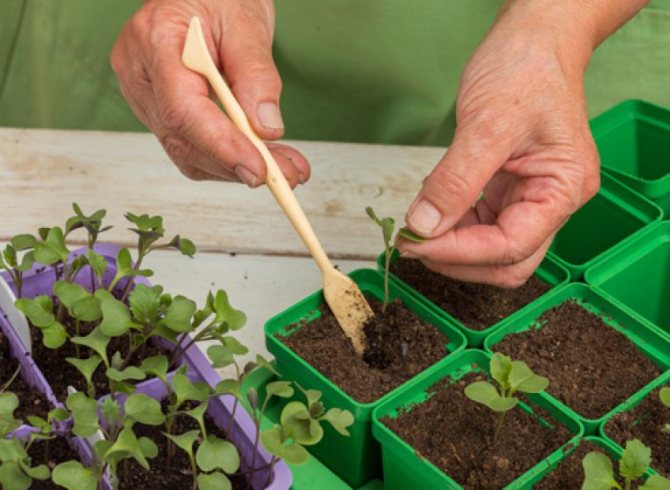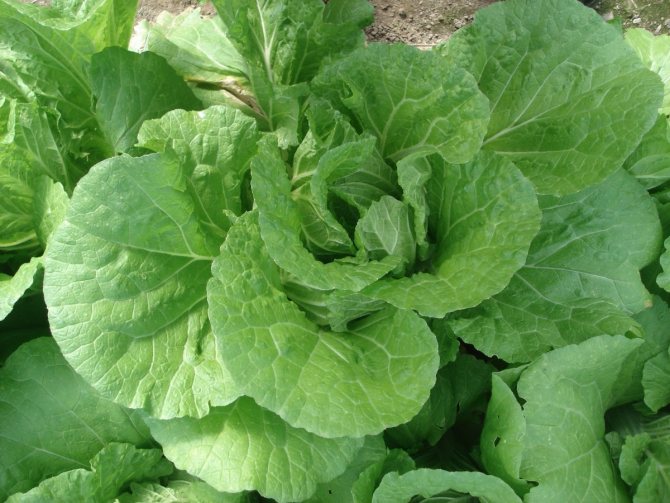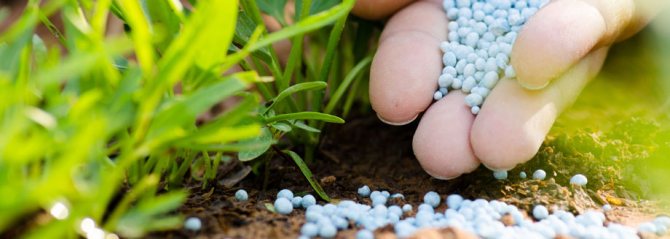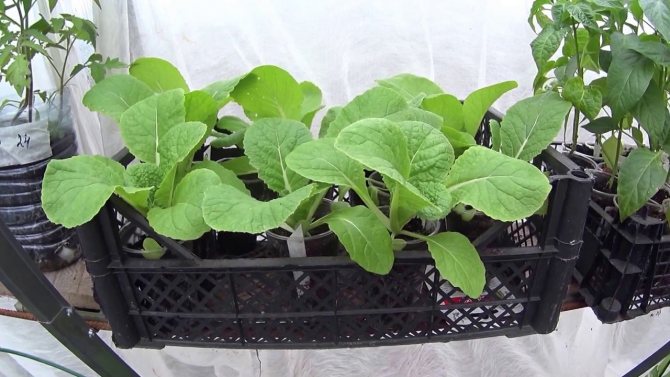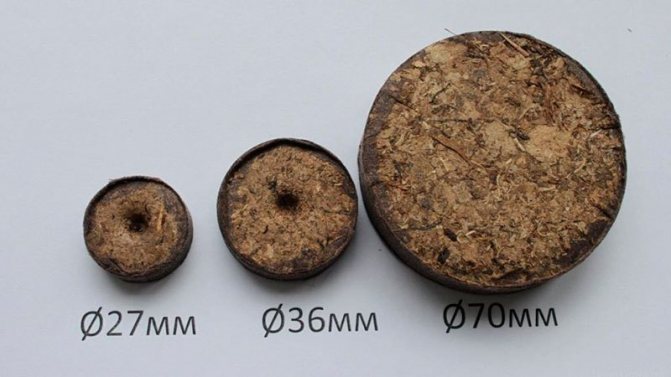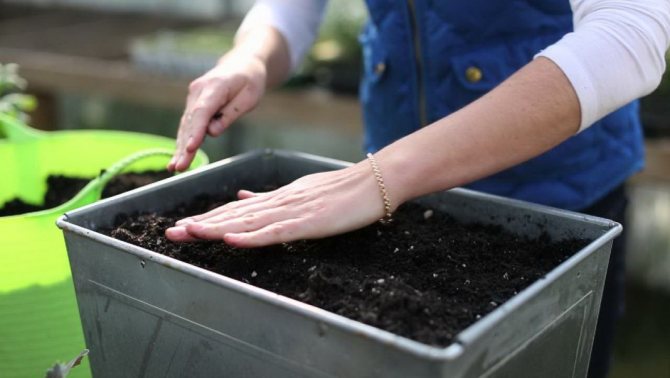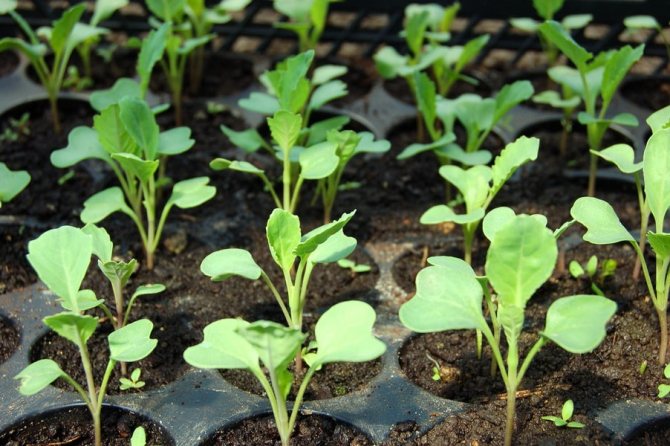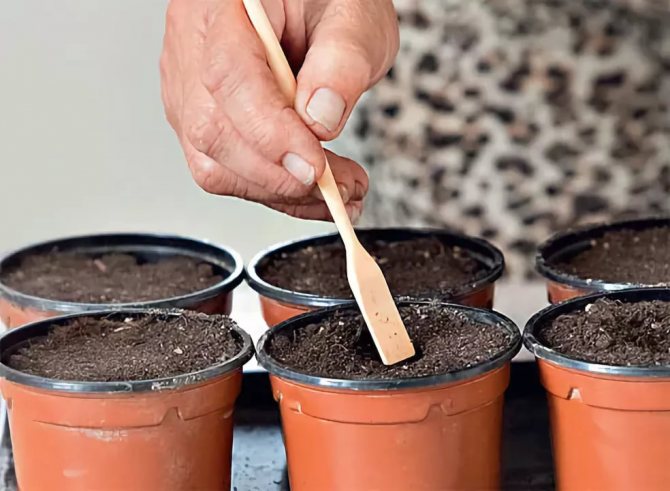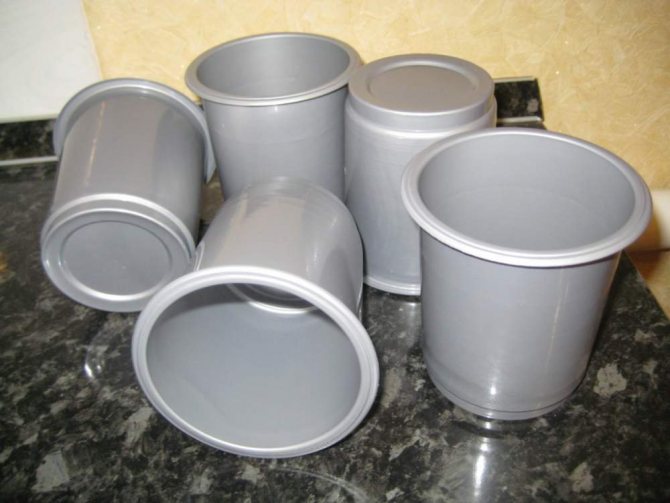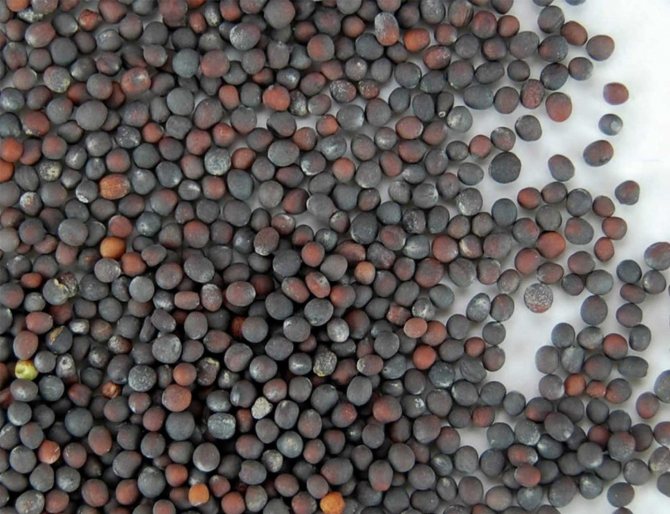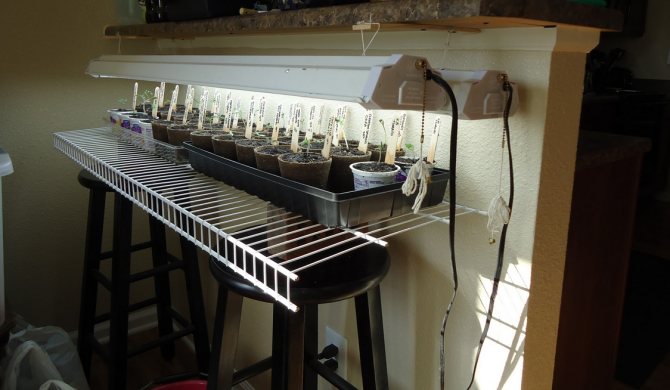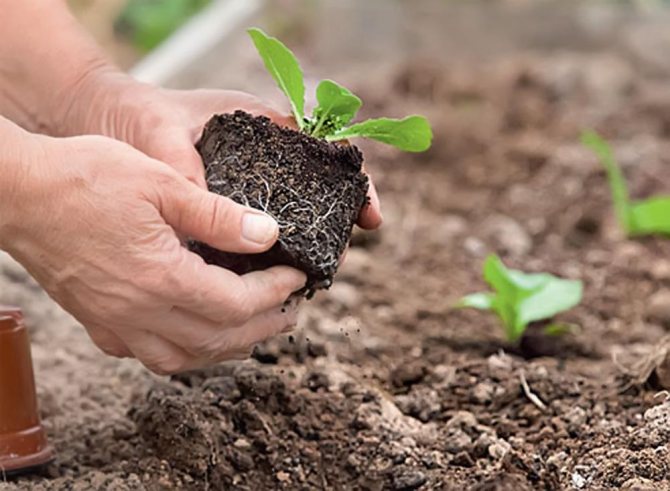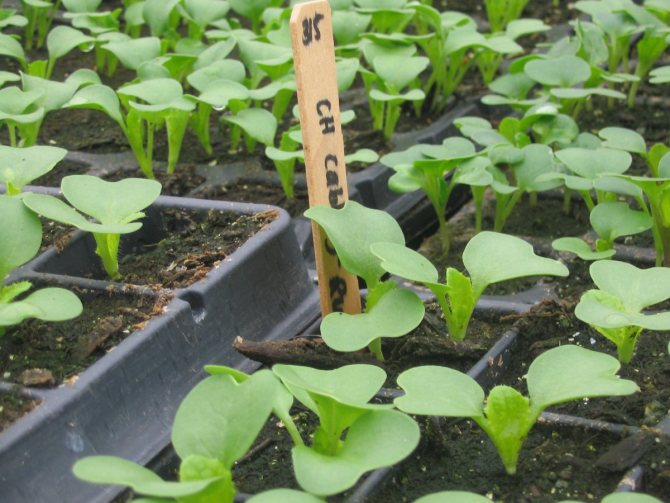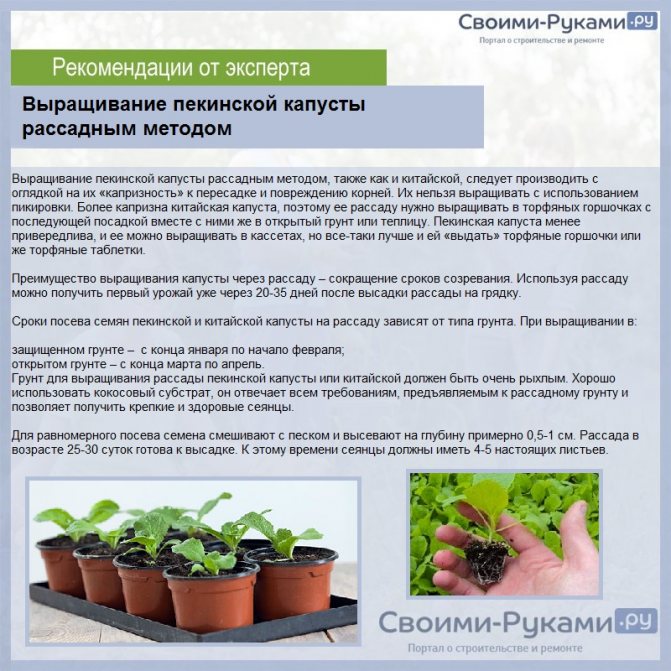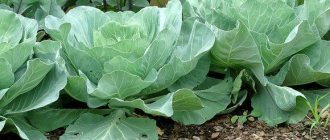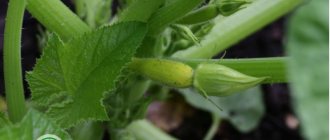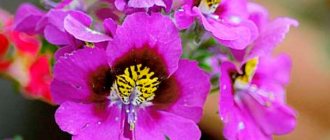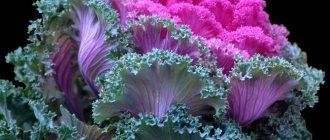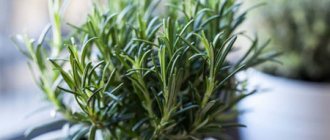For the first time, Peking cabbage was introduced into the culture in China, it was a very, very long time ago: according to some data, more than 4000 years ago, according to others, more accurate, more than 5500 years ago. This vegetable is very widely used in cooking, it lends itself well to frying, stewing, cabbage is added to a variety of soups, and consumed raw. From China, Peking cabbage came to Korea, Japan, the countries of Southeast Asia. It is interesting that in Europe they really learned "well" about Peking cabbage only 60 years ago and is now grown in almost every vegetable garden, and of course, on an industrial scale, especially in America. Our article is about the features of growing Chinese cabbage.
Planting Chinese cabbage.
Content
- Listen to the article
- Description
- Growing Chinese cabbage from seeds When to sow
- Growing Chinese cabbage seedlings
- Picking
- When to plant
- Peking cabbage care
- Pests
- Beneficial features
When is the best time to plant cabbage?
Peking cabbage is a vegetable of short daylight hours, so it should be planted during the period when daylight hours have the least number of hours. Such requirements are due to the fact that with prolonged exposure to the sun, Peking often turns into color, instead of forming a head of cabbage.
The most optimal time for planting this variety is early spring or late summer.
The method of growing Peking cabbage in two passes has proven itself quite well:
- the first sowing must be carried out between April 15 and May 1;
- second sowing - from July 20 to August 10.
Planting and caring for Chinese cabbage
- Landing: sowing seeds for seedlings - in late March or early April, planting seedlings in a vegetable garden - in late April or early May. Sowing seeds of late varieties in open ground - in July.
- Lighting: bright sunlight.
- The soil: light, loose, fertile, moderately moist, well-drained, neutral. The best soil is loamy.
- Watering: regular: once a week in the early morning or after sunset.
- Top dressing: two weeks after planting the seedlings with a solution of mullein, bird droppings or herbal tincture at the rate of 1 liter per 1 plant. Spring cabbage is fertilized 3 times during the growing season, summer cabbage - 2 times. Foliar dressing with boric acid solutions is popular.
- Reproduction: seed.
- Pests: spring cabbage fly, wavy flea, harmful centipede, cabbage moth, moth, scoop, bedbug and aphids, root and rapeseed burrowers, rapeseed bug and flower beetle, bear, turnip whiteworm, winter and garden scoops, sprout fly, gamma scoop, dark cracker and wireworm, petiolate gnat, black and cruciferous fleas and slugs.
- Diseases: black leg, black ring spot, tracheomycosis (fusarium wilting), phomosis (dry rot), vascular bacteriosis, mosaic, downy mildew, keela, leucorrhoea, white rot and alternaria.
Read more about the cultivation of Chinese cabbage below.
Subtleties of seedling care
When the seeds germinate, leave the strongest sprout, and remove the second. As soon as the remaining plant grows a little, you can begin to air the plantings by unscrewing the caps on the bottles. It is also convenient to water it through the same hole. Peking cabbage normally tolerates water from above to the head of cabbage.
The first feeding should be done when 2 real leaves are formed on the bushes. To do this, dilute 1 liter of infusion in 10 liters of water and water the plants under the root.
In the phase of 4 true leaves, remove the cap. Then carry out hilling. It is necessary to water the cabbage regularly, but in moderation, not allowing the soil to dry out, otherwise the head of cabbage will not tie well.
Secrets of a good harvest of Chinese cabbage, video
Chinese cabbage - description
Peking cabbage is a biennial plant cultivated as an annual. Peking cabbage leaves, tender and juicy, with a flat or triangular median vein, form a loose head of cabbage or rosette. The leaves have wavy or jagged edges, they are slightly bumpy on the inside, their color can vary from a light yellow to bright green. Sometimes on the veins of leaves from the outside there is a slight pubescence. The leafy forms of the plant are used to make salads, and soups are cooked from heads of cabbage, garnishes are prepared, they are pickled and dried. In East Asia, pickled Peking cabbage is prepared, calling it kimchi.
Peking cabbage is a close relative of cruciferous crops such as radishes, radishes, turnips, turnips, turnips, rutabagas, horseradish, mustard, kohlrabi, daikon, savoy cabbage, Brussels sprouts, broccoli, cauliflower, cabbage and red cabbage.
We will tell you how Peking cabbage is grown and taken care of in a greenhouse, we will describe the conditions for growing Peking cabbage and tell you how to plant Peking cabbage in the ground, how to grow Peking cabbage in the open field, how to protect it from pests and diseases, why Peking cabbage cabbage blooms, and we will also bring to your attention a description of the varieties and useful properties of Peking cabbage.
- Carrots: planting and care in the open field, harvesting and storage
We grew seedlings - we are happy with an early harvest
The fuss with growing cabbage seedlings from China is not in vain, because it makes it possible to bring the harvest time closer. The spring term for sowing is the end of March, summer - the last days of June. The Beijing multilayer vegetable is bad for transplanting to a new place, so it is best to immediately start growing it in separate containers.The ideal option is peat, which protect the crop from stress even while moving into open ground.
The selected containers must be filled with a highly friable substrate. For example, a peat-sod or coconut-humus mixture is suitable. Deepen the seeds no more than a centimeter, pour them, place them in the darkness. Expect an ascent in a few days.

Seedling of Chinese cabbage before planting in open ground
Now bring the containers out into the light. Often, seedlings should not be watered, and a couple of days before transplanting into the ground, it is necessary to completely stop moistening the soil. The young "Peking" is transferred to a permanent place in a month. At this point, there should be 4 or 5 leaves.
We planted seeds - we got Chinese cabbage
The first thing to do is to choose the right spot for growing cabbage. Two points are especially important:
- Illumination. Shade and partial shade for a light-loving Peking beauty is categorically not suitable.
- Predecessors. The cultivation of "Peking" will not be without success if you plant a vegetable in the place of potatoes, carrots, onions, and garlic. Cucumbers are a good precursor for aboveground crops. Peking has not been planted in one place for two years in a row.
To plant seeds, you need to make holes.Distance from all sides - 30 cm. It is highly desirable to prepare half a liter of humus or compost for each hole. Adding a handful of ash will also do the trick. Seeds should be immersed in wet soil 1-2 cm deep. Expect results in a week.


Peking cabbage is grown in a sunny location outdoors
It is better to make a shelter above the cabbage beds, which:
- Protects the crop from the cold - at temperatures below 13 ° C, cabbage stops developing.
- It will save cabbage from the scorching rays of the sun - the culture cannot stand more than 25 ° C.
- It will save the vegetable from waterlogging - with an abundance of precipitation, cabbage can rot.
- It will hide cabbage from a cruciferous flea - this is not a 100% method, but it is very effective.
Experienced gardeners praise this method of maintaining moisture in the soil and controlling weeds, such as mulching. You need to water the cabbage once a week, using water heated in the sun.
It is necessary to feed the culture planted in open ground from the second week. For this purpose, mullein, chicken droppings or compost are used. The selected ingredient is diluted with 10 parts of water, infused for several days and poured into 1 liter per unit of vegetation. Spring cabbage is fertilized three times, for autumn cabbage two are enough. Spraying with boric acid solution (1 g per 5 L) will help in the development of the head of cabbage.
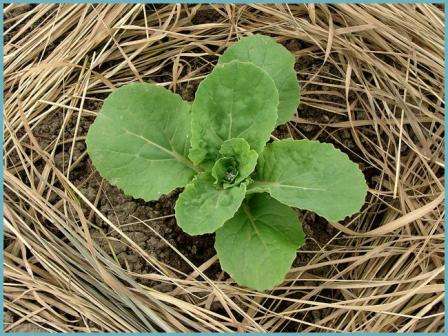

Outdoor mulching of Chinese cabbage
Take your time to harvest. An adult plant can withstand a slight negative temperature well, while continuing to develop. Usually, harvesting Chinese cabbage growing in the open field is postponed until early or mid-October. Heads of cabbage from the second run of cultivation are stored until winter.
Growing Chinese cabbage from seeds
When to sow Chinese cabbage for seedlings
The cultivation of Peking cabbage is carried out using a seedling and seedling method. Peking cabbage is a cold-resistant plant - its seeds germinate at a temperature of 4 ºC, but normal growth and development of the culture begins only at a temperature of 15-22 ºC. At higher temperatures, Chinese cabbage turns into color, especially in conditions of long daylight hours. That is why it is recommended to use the seedling method of growing a crop, which allows you to get the first crop already 3-4 weeks after planting seedlings in the ground.
Peking cabbage seeds are sown for seedlings about a month before the seedlings are planted in open ground - in late March or early April if you want to get an early harvest, and at the end of June if you need Chinese cabbage for winter consumption.
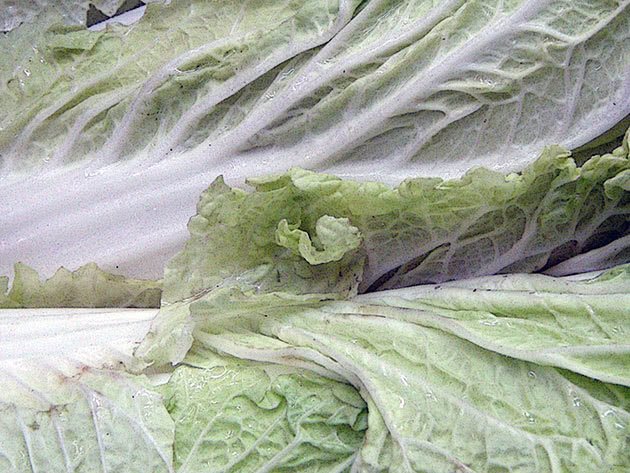

Growing Chinese cabbage seedlings
Sowing seeds of Peking cabbage is carried out in loose soil, for example, a soil mixture of two parts of coconut substrate and one part of humus. However, the problem of this culture is that it is hard to go through a dive, so it is preferable to sow seeds not in a general container, but three pieces in separate peat pots or peat tablets - in this case, you will not have to injure the seedlings either when diving or when transplanting into open ground. Dry seeds are embedded in a moist substrate to a depth of one and a half centimeters and placed in a dark, warm place until the seeds germinate.
A few days later, when shoots appear, the crops are brought out into the light. The temperature of the seedlings at this time should be no higher than 7-8 ºC - keep the seedlings on a glassed-in balcony or loggia.
How to care for Chinese cabbage during this period? Watering is carried out with warm, settled water as needed, when the upper layer of the substrate dries up, after watering, the moist soil is carefully loosened. When the grown seedlings of Peking cabbage develop 2-3 true leaves, only one of the strongest seedlings is left in the pots, and the weak ones are pinched off so as not to pull out the roots of the remaining seedling.
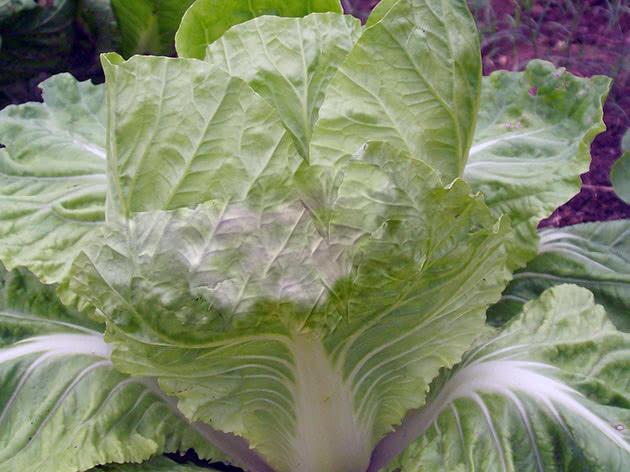

Peking cabbage pick
As we already wrote, in view of the fact that the seedlings of Peking cabbage do not tolerate a dive well, you need to sow its seeds not in a common dish, but in separate containers in order to avoid injury to the roots of seedlings when diving and transplanting into open ground.
Growing at home
Peking cabbage can be grown not only in the garden, but also at home.
This will require:
- fresh cabbage forks purchased from the store;
- container with water;
- a pot of earth.
Procedure:
- For cultivation, it is advisable to choose a head of cabbage with a thick stump.
- In order for the leaves to grow abundantly, the head of the fork is cut off, retreating from the stump of at least 5 cm.
- Put the root in a container with water and put it in a cool place (not in the refrigerator).
- A few days later, when the root system has developed, the plant is planted in a pot of soil. Care is required not to damage the fragile roots.
- Cabbage is placed in a lighted place and watered regularly - as needed, avoiding waterlogging.
Leaves will soon appear on the plant that can be eaten.


Growing Peking at home
Planting Chinese cabbage in open ground
When to plant Chinese cabbage in the ground
Growing and caring for Peking cabbage in the open field begins with planting its seedlings in the garden. Peking cabbage is planted at the stage of development in seedlings of 5-6 true leaves, when at least three weeks have passed since the emergence of seedlings.
10 days before planting, the seedlings begin to harden - the seedlings are taken out into the yard for a short time every day, gradually increasing the duration of their stay in the fresh air. When the seedlings can spend the whole day in the yard, they are ready for planting in the garden. 3-4 days before transplanting, they stop watering the seedlings so that the seedlings do not overgrow, but immediately before planting they are watered abundantly.
Soil for Chinese cabbage
Since we are talking about a light-loving culture, Peking cabbage is planted in open, sunny areas. The soil for Chinese cabbage needs neutral, light, loose, but fertile, moderately moist and well-drained, and loam is most suitable in this regard.
The best precursors for Chinese cabbage are green manures, carrots, potatoes, legumes, grains, onions, garlic, and cucumbers. And after garden plants such as all crucifers, beets and tomatoes, it is better not to grow Peking cabbage, since these crops have common diseases and pests.


How to plant Chinese cabbage
Before planting Peking cabbage, the site should be prepared, and if the soil needs to be limed, they do it in the fall - dolomite flour or lime is added to the soil for digging. In the spring, the plot is dug up, adding a bucket of humus or compost to each m², and harrowed. After that, holes are made: if you need cabbage for salad, the holes are placed in a row at a distance of 10-15 cm with a row spacing of 40-50 cm, and if you grow Peking cabbage for heads of cabbage, then the distance between holes in a row should be 30-40 cm with the same row spacing.
Before planting, 2 tablespoons of superphosphate, 2 cups of wood ash and a teaspoon of urea are placed in each well, the fertilizers are thoroughly mixed with the soil and the wells are spilled well with water. A peat pot with a Peking cabbage seedling is placed in the center of the hole and added dropwise.
How and where to plant the crop?
Due to the fact that cabbage heads are large enough and require a lot of space, experienced gardeners advise sowing seeds directly into the ground. In addition, Peking does not tolerate picking, so a seedless growing method is the best for her.
The site for planting crops should be well lit, while it is necessary to avoid swampy and acidic soils. Peking cabbage grows well in the beds where garlic, onions, cucumbers, and potatoes were previously grown.
Before sowing seeds, sand must be added to the loamy soil and the beds must be dug up. Spill the soil with high acidity 2 weeks before sowing with a solution based on dolomite flour or slaked lime (200 g per 10 l of water).
It is necessary to sow seeds in warm soil. To do this, cover the future beds with black film and leave for 14 days.
After the specified time has elapsed:
- add ash to the site and make holes with a diameter of 15 cm, leaving a distance of 40 cm between them - with a closer planting, the cabbage will develop poorly and hurt;
- compact the earth and sow 2 seeds each;
- sprinkle with a thin layer of earth;
- cover with a cap from a cut plastic bottle with a capacity of 5 liters (do not open the cap on the bottle yet).
How to grow Chinese cabbage in the garden
Peking cabbage care
How to grow Chinese cabbage correctly? Planting and caring for Chinese cabbage requires adherence to some simple rules. At the first time after planting seedlings on the garden bed, it must be covered with non-woven material. Why is this done?
- Arabis: planting and care in the open field, growing from seeds
- Firstly, in order to protect young plants from frost or sudden changes in temperature.
- Secondly, to shade them from direct sunlight, which during the rooting of seedlings can harm them.
- Thirdly, in order to protect the root system of Peking cabbage from decay during the period of heavy rains.
- Fourth, to hide the seedlings from the cruciferous flea - the most common pest of cabbage crops.
- Fifth, so that Peking cabbage, covered overnight, forms heads of cabbage faster.


Two weeks after planting Peking cabbage in open ground, the site should be mulched with straw or peat. It is not necessary to huddle Chinese cabbage, but it is necessary to carefully loosen the soil around it, while simultaneously removing weeds from the garden. For the rest, the measures for caring for Peking cabbage are the same as for any other type of garden cabbage - watering, feeding, protection from pests and diseases.
Watering Chinese cabbage
Peking cabbage in the garden requires regular and abundant watering - once a week with warm water. Water is poured under the root so that it does not fall on the leaves. Watering is carried out early in the morning or after sunset. To prevent moisture from evaporating from the soil so quickly, do not forget to mulch the garden - this is how you water the Beijing cabbage, and loosen the soil around it, and you will have to remove weeds much less often.
Top dressing of Chinese cabbage
The first feeding of Peking cabbage is carried out two weeks after the seedlings were planted in the ground, and it should consist of organic fertilizers. For example:
- one part mullein, dissolved in 10 parts water;
- one part of chicken manure, dissolved in 20 parts of water;
- one part of herb infused with 9 parts of water.
Organic fertilizer consumption - 1 liter of ready-made solution per plant.
Peking cabbage, planted in spring, is fertilized three times during the growing season, and the one that was planted in summer only twice.
In addition to the described nutrient compositions, foliar dressing has a good effect on the formation of Peking cabbage forks: 2 g of boric acid are dissolved in 1 liter of hot water, after which another 9 liters of cold water are added to the solution. Peking cabbage is processed with this composition on the leaves. Better to do it in the evening.
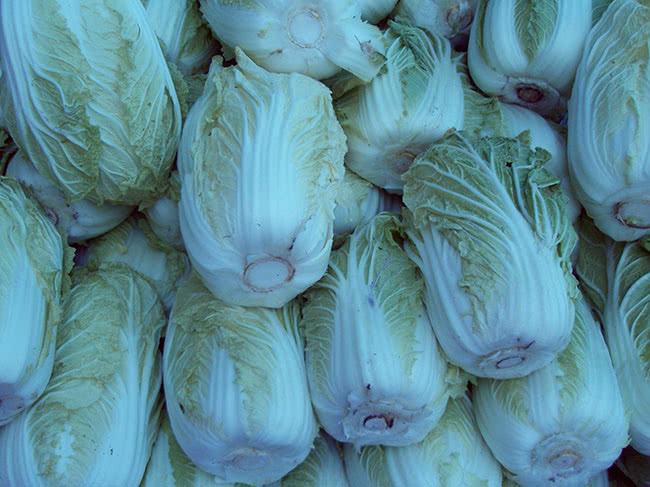

Chinese cabbage has bloomed
How does Beijing cabbage grow? Peking cabbage forms heads of cabbage only with short daylight hours. In areas with a warm climate, this is early spring and late autumn. After seed germination, Peking cabbage first forms a rosette of leaves, and only after accumulating a certain amount of protein, sugars and vitamins, the plant begins to form an elongated head weighing 1-2 kg or more, after which Peking cabbage very quickly turns into color. As soon as 10 leaves are formed, the rudiments of flowers are formed in the central bud, and the head gives an arrow.
What could trigger Peking cabbage to shoot before it forms heads? Long daylight hours and high air temperature.That is why the middle lane is perfect for growing Peking cabbage, and growing Peking cabbage in Siberia is much easier than in the southern regions.
What to do if Chinese cabbage has bloomed? Learn the rules of growing crops, find your mistakes, analyze them and not repeat them next year. Don't be discouraged: negative experiences are sometimes more valuable than positive ones. Anyway, you now know how Peking cabbage blooms.
Chinese cabbage in the greenhouse
In order to grow Peking cabbage in a greenhouse, it is necessary to observe a certain temperature regime and maintain the necessary air humidity. Grow cabbage at temperatures no higher than 15-20 ºC, as higher temperatures can lead to flower stalk formation and various diseases. The optimum humidity for Peking cabbage grown in a greenhouse is 70-80%.


You can sow Peking cabbage seeds in greenhouses or plant seedlings in a greenhouse. The technical ripeness of cabbage grown from seedlings occurs on average a week earlier than that grown in a greenhouse from seeds. The requirements for the greenhouse soil are the same as for the soil in the garden. Peking cabbage is fertilized in a greenhouse with organic matter or mineral nitrogen fertilizer.
Biologically characteristics of the species
The plant forms a rosette of upright leaves, the usual hard head of cabbage is completely absent, the height is within 30-50 cm. The leaves are soft, without an unpleasant specific taste, they are used for food both raw and cooked.
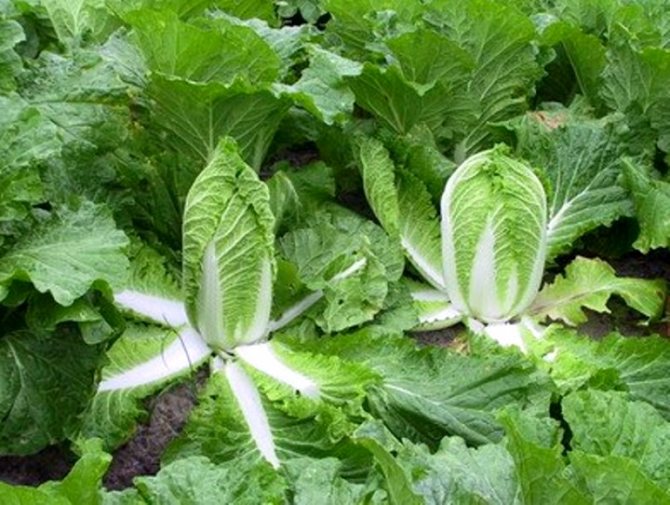

- The plant is early maturing. The earliest varieties yield 40 days after germination. Late varieties ripen on day 60. This early maturity allows in some zones to grow three crops per year in the open field. In greenhouses, year-round cultivation is possible.
- Lowering the temperature to + 13 ° C can be a trigger for the appearance of arrows and peduncles. The same effect is caused by long daylight hours. Agronomists advise temperatures for maximum yield of + 15–20 ° С. Breeders have created special hybrids that are resistant to temperature drop, which minimizes the likelihood of flower stalks. In areas with a risky climate for agriculture, it is recommended to use these varieties.
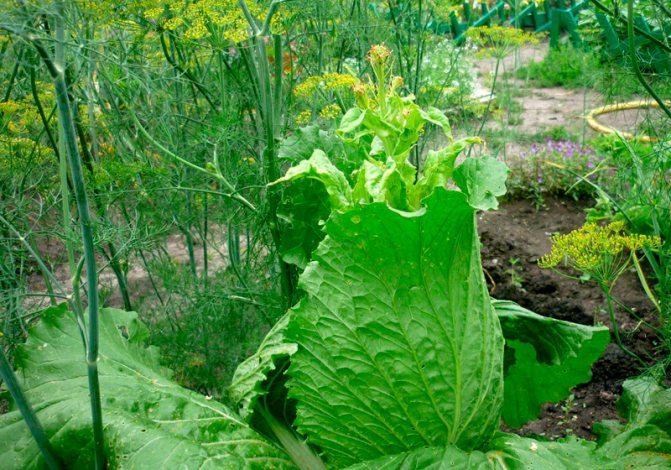

How to properly grow Chinese cabbage
Among the advantages, Peking cabbage also has significant drawbacks - it cannot be stored under normal conditions, requires refrigeration chambers, a strictly set temperature, the presence of inert gases in the air, etc. our compatriots dishes.
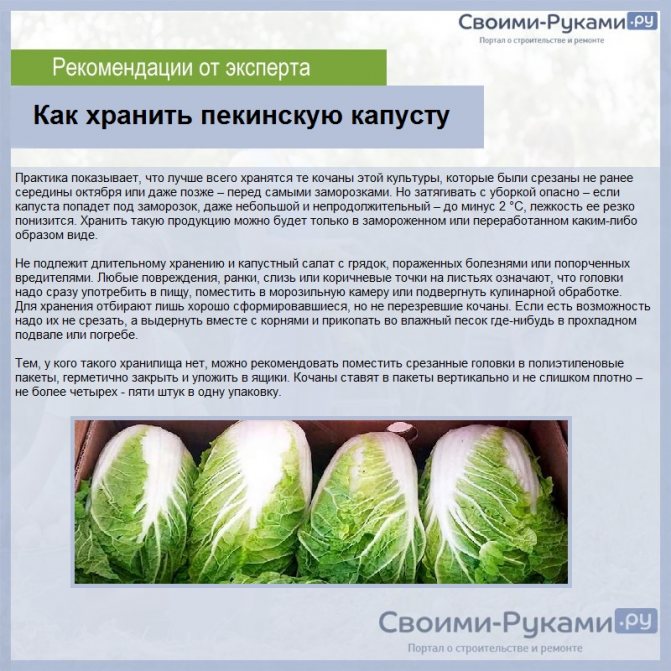

How to store Chinese cabbage
Peking cabbage is planted for gradual use on greens or on heads of cabbage. In the first case, the leaves are cut as needed, in the second case, they wait until the head is formed. This will take no more than 60 days. The head of cabbage is not stored for a long time, you need to keep this in mind when planning the number of beds for this vegetable.
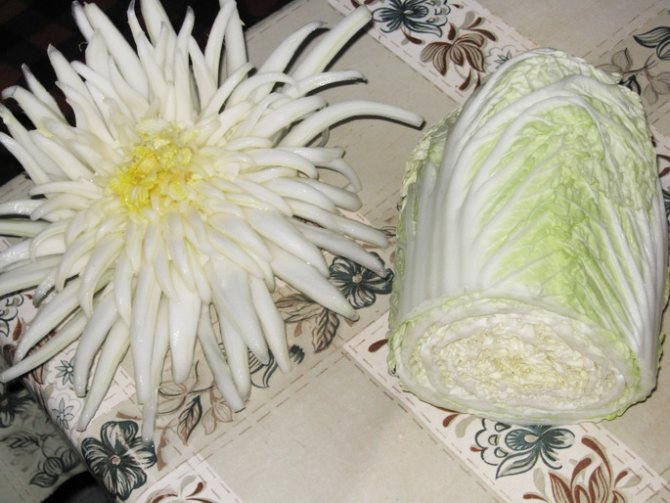

Think about how you will use the crop
There are a lot of varieties and hybrids, if you wish, you can leave a few inflorescences for the seeds to ripen. Just keep in mind that hybrids do not retain their qualities; for breeding, use only varietal Peking cabbage.
Cabbage leaves contain 3.5% protein, 2.4% sugar, almost a full range of mineral salts and amino acids. During heat treatment, a large amount of nutrients are lost; it is better to cook food raw.
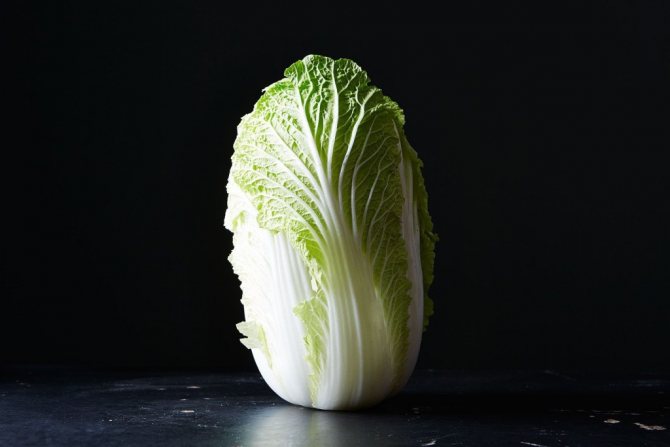

Peking cabbage is better not to be heat-treated.
Pests and diseases of Chinese cabbage
Peking cabbage pests
We have written about diseases and pests of cruciferous crops many times, so it makes no sense to cover this topic in detail once again.Briefly, we recall that among insects dangerous for culture are spring cabbage fly, wavy flea, harmful centipede, cabbage moth, moth, scoop, bedbug and aphids, root and rapeseed hunters, rapeseed bugs and flower beetles, bear, turnip white beetle, winter and garden scoops, sprout fly, gamma scoop, dark nutcracker and wireworm, petiole gnat, black and cruciferous fleas and slugs.
Peking cabbage diseases
Diseases, like pests, are common in all cruciferous crops, and we have given a detailed description of these diseases in our articles many times.
Most often, crucifers, including Chinese cabbage, affect:
- blackleg,
- black ring spot,
- tracheomycosis (fusarium wilting),
- phomosis (dry rot),
- vascular bacteriosis,
- mosaic,
- downy mildew,
- keel,
- linen,
- white rot
- and alternaria.
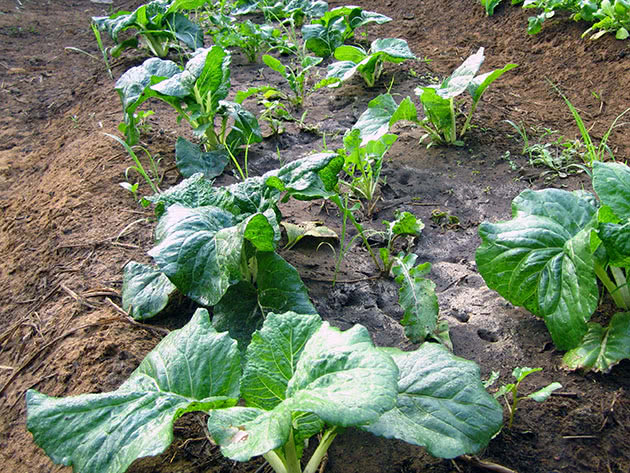

Peking cabbage processing
In order to grow a quality product, it is necessary to follow the rules of agricultural culture and care for it. This is usually enough to ensure that diseases and pests never appear on your site. But if suddenly the plant does get sick or pests begin to dominate the garden, you need to know what measures will help you get rid of these troubles.
- Solanaceous plants: fruit and ornamental
How to process Chinese cabbage? You need to fight fungal diseases with fungicides - Fundazol, Quadris, Skor, Ridomil, Topaz, Horus and other drugs of a similar action. Plants cannot be cured from viral diseases (mosaic, black ring spot, for example), the affected specimens must be removed from the site and burned so that the infection does not spread to healthy plants.
You can save yourself from pests by treating Peking cabbage with insecticides, and in cases with arachnid insects - insectoacaricides. It is unlikely that you will be able to get rid of them after one spraying, but no matter how many times you have to treat Peking cabbage from pests, the last treatment should be done no later than a month before harvesting.
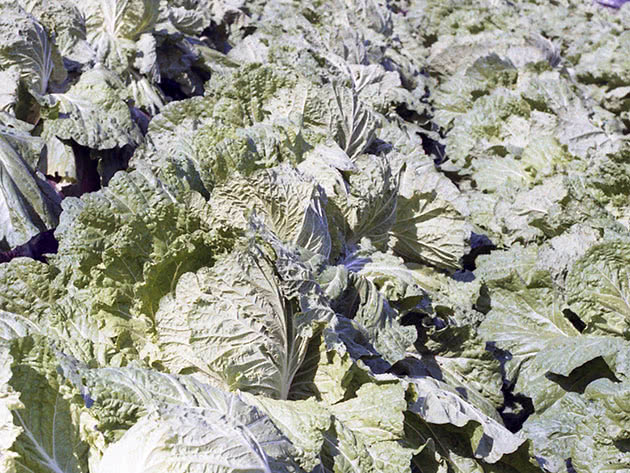

And yet the most reliable protection of the garden from diseases and pests is prevention. Observe crop rotation and agricultural practices, plant seedlings in open ground as early as possible, when planting, observe the required interval between specimens, properly care for Peking cabbage, after harvesting, remove all plant residues from the site and carry out a deep digging of the soil.
How to choose seeds
To buy seeds, it is better to contact specialized stores, where consultants will be able to competently answer all your questions and you can not worry about the quality of the goods and the storage conditions of the seeds. It is better to take seeds for future use, with a 25% stock.
The number of seeds purchased for planting depends on the following factors:
- sowing area,
- personal needs,
- sowing frequency on the site,
- % probability of emergence of all seeds.
The latter depends largely on the growing conditions. Therefore, for complete confidence, you should adhere to the rule: in one hole - at least 3 seeds.
Recommended seeding frequency for Chinese cabbage is 30x25 pattern.
From these factors it follows that 1 sq. M. the site will need at least 12 seeds. Considering that the number of seeds in 1 g = 400, then this amount is enough to sow a plot of up to 34 sq. M.
Over time, it will be possible to calculate the number of seeds per eye, but if this is the first experience of growing Chinese cabbage, you should use this "cheat sheet".
If you do not want to count the seeds, you can mix them with sifted river sand in a 30/70 ratio and pour the finished mixture in small quantities into the holes.
It is important to consider the percentage of seed germination. On average, it is 25-75%. Therefore, counting on a rich harvest, you cannot skimp on the frequency of sowing.
Peking cabbage harvesting and storage
Peking cabbage is cold-resistant - it can be left in the garden until mid-October. A head of Peking cabbage is considered ripe, having acquired a density. Peking cabbage planted in spring is unsuitable for storage, and the one sown in July can be stored until the new year and even longer.
No special conditions are required for storing Chinese cabbage. You can keep Chinese cabbage in a relatively dry basement or cellar by wrapping each cabbage in plastic and storing it in a wooden box. Approximately once every two weeks, the heads are examined, the damaged areas are cleaned, if necessary, and wrapped in a new film. Optimal conditions for storing Peking cabbage are temperatures from 0 to 2 ºC and humidity within 95%.
Do not store Chinese cabbage in the same room as apples, as these fruits release ethylene, which causes the leaves of Chinese cabbage to wither prematurely.
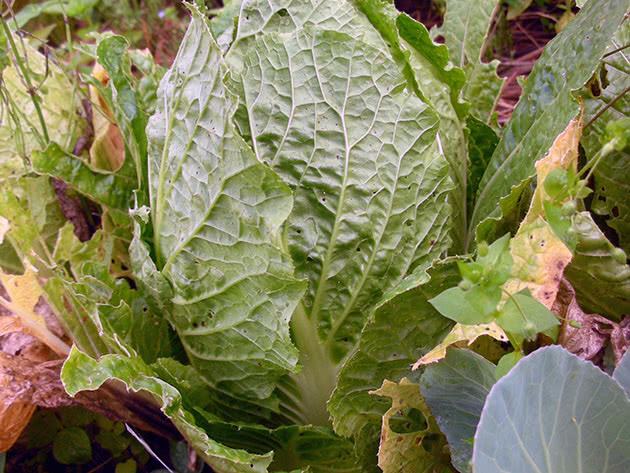

If you do not have a cellar or basement, or it is impossible to keep Chinese cabbage in them, try to arrange for storage in a glassed-in loggia or on a balcony if the temperature there does not drop below 0 ºC in winter. Wrap each head in plastic wrap and place in a drawer. When cold weather comes, you can always cover the cabbage with an old blanket or coat.
Firm and healthy heads of cabbage without any signs of spoilage can be stored wrapped in plastic in the refrigerator.
Well, in the end, Peking cabbage can be dried in an oven or electric dryer and then stored in fabric bags, or you can ferment or chop and freeze.
Peking cabbage sourdough method: 5 kg of cabbage is finely chopped, add 50 g of vinegar, 300 ml of water, a teaspoon of salt and sugar each, squeeze one clove of garlic through a press, mix, put in a jar or ceramic container, press well and set on top oppression. A day later, the cabbage is pierced to the very bottom, for another day it is left at room temperature, after which it is removed in the cold. Sauerkraut will be ready to eat in two weeks.
Method two - growing by sowing in the ground
In an effort to obtain an earlier harvest, sowing the seeds of Peking cabbage should be sown as early as April. But by this time, the average daily temperature is rather unstable and there is always the possibility of night frosts. In this case, you cannot do without shelter. But in order not to clutter up the site with buildings of additional greenhouses and not to complicate maintenance, you can use a fairly simple, but very effective method that many gardeners use.
So, the most warm and sunny place is chosen on the site, usually on the south side near the fence or wall. The soil is loosened and small holes are prepared, according to the planting scheme. A couple of handfuls of humus are poured into each, if the earth has dried out and watered, put a couple of seeds and sprinkle with soil with a layer of no more than 1 cm. Cover each well on top with a 1.5-2 liter transparent plastic bottle with the neck cut off, pressing the edges into the ground. In such mini-greenhouses, a favorable microclimate is created with a certain temperature and humidity.
Planting care is simple. Due to the lack of evaporation, cabbage does not require frequent watering, and it is quite difficult for pests to penetrate under the plastic cap. Therefore, the shelter can be left until the time when the heads of cabbage become cramped.
Video on how to grow Peking cabbage
Important! Do not forget about the artificial reduction of daylight hours, otherwise all your plantings will go in "color" and you will not have a good harvest. To do this, at about seven or eight o'clock in the evening, throw a black film on the garden bed, and in the morning, also at seven or eight, do not forget to remove it.
That, perhaps, is all the cultivation - by the beginning of summer you will already have the first green heads of early cabbage!
Types and varieties of Chinese cabbage
Peking cabbage varieties are divided into early, mid-season and late ripening according to the ripening period.
Early varieties of Chinese cabbage
The best early maturing varieties are:
- Vesnyanka - a leafy variety, resistant to flowering, ripening 35 days after germination. Vesnyanka leaves are bare, their central vein is juicy:
- Champion - an early ripe hybrid resistant to shooting with compact heads of cabbage and a well-closed top;
- Sprinkin - an early hybrid, ripening in 55-60 days, with cylindrical heads of cabbage with a rich dark green color;
- Lenok - an excellent salad variety for growing in greenhouses: leaves slightly covered with a waxy bloom are collected in a head of cabbage weighing an average of about 300 g;
- Asten - a variety of Dutch selection exclusively for open ground, dark green heads of cabbage weighing one and a half kilograms ripen in 55 days.


The early ripening varieties of Peking cabbage Kudesnitsa, Monaco, Victoria, Polukochanaya, hybrids Hydra, Gorki, Naina, Tenderness, Richie, Spectrum, Martha, Optico, Rossem, Northern Beauty, Orange Mandarin have also proven themselves well.
Mid-early and mid-season varieties of Peking cabbage
There are more varieties and hybrids of this group than early or late ones. The most popular ones are:
- Beijing Express - a variety that ripens within 70-75 days, resistant to unfavorable conditions, with light green cylindrical heads of cabbage weighing up to 2 kg;
- Garnet - a high-yielding medium-early variety, ripening in 65-70 days, with dense cylindrical heads of dark green color weighing up to 2.5 kg;
- Vorozheya - mid-season semi-cabbage variety with wide elliptical flat blistery leaves with slight pubescence;
- Cha cha - mid-early, maturing in 50 days, resistant to stemming hybrid with heads of cabbage weighing almost 3 kg;
- Wineglass - mid-season, resistant to stemming, ripening in 70 days, with medium-sized heads of cabbage weighing up to 2 kg. Inner leaves are light yellow;
- Brocken - mid-season, high-yielding variety, resistant to flowering, with half-open heads of cabbage of medium density weighing up to 2.5 kg. The variety is well kept;
- Rolnik - shade-tolerant cold-resistant variety with yellow-green heads of cabbage weighing up to 200 g with a weak waxy bloom;
- Autumn beauty - mid-season hybrid (80-85 days) with half-open heads of cabbage of medium density weighing up to 2.5 kg. Heads of cabbage in the cut are yellow.
Hybrids Bilko and TSKHA 2 also performed well.
Late varieties of Chinese cabbage
Since Peking cabbage, in principle, is a rapidly maturing culture, there are not so many of its late varieties. The best ones are:
- Nozaki - the growing season of this variety is 85-90 days, the heads of cabbage are wide-elliptic, half-open, but at the same time dense, in the context of yellow-green, weighing about 1.5 kg;
- Russian size - cold-resistant variety with heads of cabbage of a beautiful creamy yellow color weighing up to 3-4 kg;
- Nika - poorly kept fresh, late-ripening hybrid with broad-elliptical dense heads of cabbage weighing up to 3 kg. This variety is most suitable for salting;
- Monument - not very productive variety, ripening in 70 days, with heads of cabbage weighing up to 3.5 kg;
- Parking - a late-ripening hybrid with excellent palatability with dense heads weighing up to 1 kg.
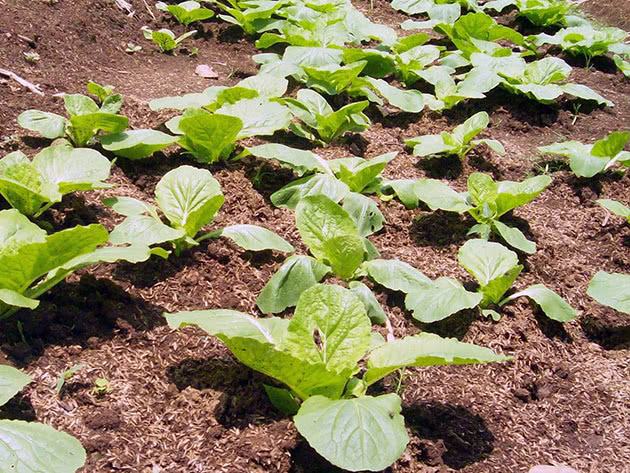

Delicious Chinese cabbage
The most delicious Peking cabbage is the Shirokolistnaya variety, the growing season of which is 45-50 days. It is a high-yielding variety that looks like Roman Romaine lettuce. With timely planting, the first harvest of Broadleaf can be harvested in June.
Of the half-cabbage varieties of Peking cabbage, the early ripening high-yield variety Khibinskaya is considered to be the deservedly the most delicious, which ripens in the open field in 40-50 days, and in a greenhouse in 20-25 days. This variety has a strongly leafy spreading rosette and an elongated, cylindrical head of cabbage.
The most delicious head varieties are Martha and the varieties and hybrids already described in the article Champion, Nika, Cha-cha and Russian size.
Peking cabbage for Siberia
The cultivation and care of Peking cabbage in Siberia is no different from the cultivation of this garden form in the middle lane. Therefore, the varieties here can be grown the same as in the Moscow region. But if you are afraid that the weather will let you down, give preference to early and early ripening varieties of Peking cabbage, for example, such as Polukocannaya, Marfa, Optico, Lenok, Asten, Orange mandarin, Vesnyanka or hybrids Tenderness, Victoria, Monaco, Rossem and Northern Beauty.


I planted it on time - I got a lot of cabbage!
The cultivation of a Beijing leafy vegetable is in many ways different from the cultivation of the white one we are used to. The main feature is shooting with long daylight hours. In this case, the normal development of the vegetable stops and the plant is rebuilt to form seeds. We are no longer talking about full-fledged heads of cabbage. There is only one way out of the situation - to plant a crop when the light period of the day is minimal.
The cultivation of cabbage from Beijing begins:
- in mid-April - for summer use;
- from late July to early August - for storage.


It is important to take into account the ripeness rate of the selected variety. Heads of early cabbage will appear on your head in a maximum of 40 days after planting. It will take no more than 60 days to grow mid-season varieties. Late varieties of "Peking" ripen on average in 70 days.
Advice! In order to be guaranteed not to collide with the flowering of cabbage, which is usually called Peking cabbage, purchase varieties endowed with resistance to this. Try to choose from Dutch hybrids.
Properties of Chinese cabbage - harm and benefit
Useful properties of Chinese cabbage
The benefits of Peking cabbage for the human body are primarily in its composition. Chinese cabbage contains vitamins A (beta-carotene), C (ascorbic acid), U, P, K (phylloquinone), E (tocopherol), B1 (thiamine), B2 (riboflavin), B3 (niacin or PP vitamin), B4 (choline), B5 (pantothenic acid), B6 (pyridoxine), B9 (folic acid), macronutrients phosphorus, potassium, calcium, magnesium, chlorine, sodium, sulfur, trace elements manganese, iron, zinc, copper, fluorine and iodine, vegetable protein, carbohydrates, dietary fiber, sugars and fats.
Peking cabbage is a valuable dietary product that has a healing effect on headaches, nervous disorders and depression, diabetes mellitus. It is an excellent prophylactic and therapeutic agent for cardiovascular diseases, in particular hypertension and atherosclerosis. Its delicate fiber has a beneficial effect on the gastrointestinal tract, it is indicated even for patients with gastritis and gastric and duodenal ulcers.
Peking cabbage is included in the daily diet for radiation sickness; it removes heavy metals from the human body. Due to the lysine contained in Beijing, regular consumption of Chinese cabbage dishes increases immunity to diseases. In China and Japan, Chinese cabbage is considered a product that guarantees longevity, precisely because of its lysine content, since this essential amino acid purifies the blood, having the ability to dissolve foreign proteins.


Peking cabbage is useful for anemia, as it stimulates the formation of leukocytes and erythrocytes in the blood. Peking cabbage promotes the removal of excess cholesterol from the body, prevents fatty liver and the formation of tumors.
Peking cabbage is ideal for those looking to lose weight, as it contains enough fiber to fill the stomach, but it is also a low-calorie food.
But the most important value of Peking cabbage is that it, unlike other vegetables, retains vitamins throughout the winter, therefore it is an indispensable product in winter and spring.
Beneficial features
Why is Beijing becoming more and more popular? This plant is a source of nutrients and vitamins. The main advantage of the variety is that even in winter it does not lose its vitamins and benefits the body.
The most important useful substances that are included in its composition include:
- protein;
- mineral salts;
- vitamins C, A, K, PP, as well as a group of B vitamins;
- amino acids;
- organic acids.
In addition, "Peking" also has medicinal properties. It helps:
- with cardiovascular diseases;
- stomach ulcer;
- strengthens the immune system;
- prolongs the life of a person.
Spreading culture
"Beijing" outside the Celestial Empire gradually spread - first, through northern China and the Korean Peninsula, it came to Japan. In the 20th century, Japanese breeders bred many varieties and hybrids of Peking cabbage - they surpassed their predecessors in maturity, yield and taste.
When the "Peking" hit the markets of Europe and America, it caused a real sensation. The great taste of this vegetable quickly won over local consumers, and farmers rushed to grow new cabbage en masse. Peking cabbage has been known in Russia for about 10 years, now this vegetable continues to be actively introduced in domestic vegetable growing.
Harvesting
Harvesting time is individual. For eating as a substitute for green salad, harvesting begins when the leaves reach 10 cm, and for long-term storage, harvesting and stewing, cabbage should be harvested when the leaves close together.
You need to harvest in dry weather, excess moisture on the leaves leads to damage to the cabbage.
If you leave a growth point when cutting a leaf, then new ones will grow over time. Heads of cabbage can be cut earlier. This will avoid the shooting process. After harvesting, you need to remove the remaining roots.
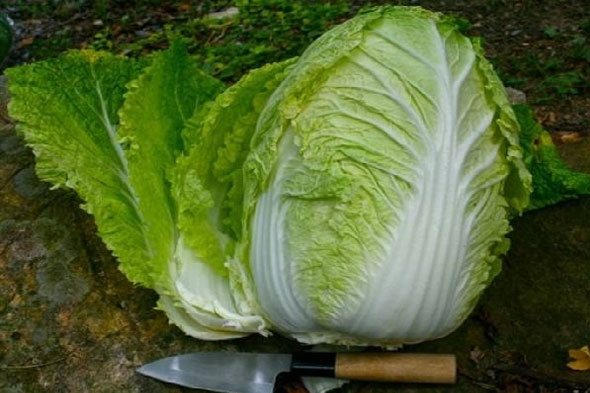

Usually, the harvesting of crops planted with seedlings is carried out until mid-July, and with seeds until October, depending on the variety (from 40 to 80 days). The weight of the "autumn" head of cabbage varies depending on the variety and can reach from 1.2 kg to 2.5 kg.
How to harvest and store Chinese cabbage
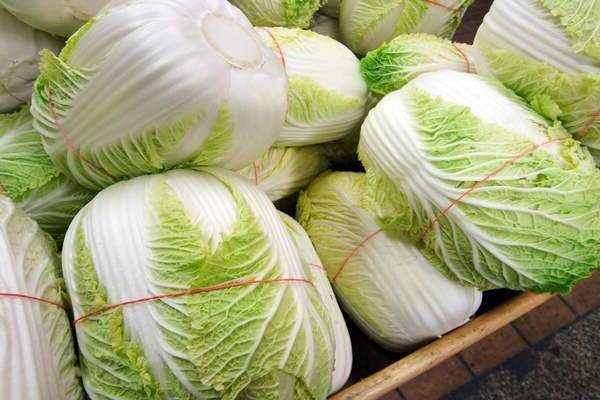

This culture is cold-resistant, can withstand temperatures up to -3 degrees. Therefore, the second crop is often harvested from mid-October to mid-November (depending on the region).
Cabbage planted in the spring months is harvested based on the density and maturity of a particular variety. They are removed by cutting off the pump.
As mentioned above, summer-planted Chinese cabbage is taken for storage. It will remain well at + 4 ... + 6 degrees and air humidity up to 85%.
Probably, many have seen that in stores this delicious product is sold wrapped in thin plastic. It is in such a film in the refrigerator that Chinese cabbage can be stored for a long time.
And cabbage, planted in the spring months, is used for food or processing.
Best predecessors
Peking cabbage is recommended to be grown after legumes and grains. The best precursors for "Peking" are crops after which the soil retains a sufficient amount of nutrients.
Favorable predecessors:
- tomato;
- potatoes;
- zucchini;
- cucumbers;
- onion;
- carrot.
It is not recommended to plant Peking cabbage in areas where crops have grown with which it has common pathogens. Unwanted precursors are other types of cabbage and beets.
Harvest
Peking cabbage for storage is grown only late planting. The harvest from spring plantings is not stored for a long time. Therefore, picking cabbage early is not recommended.
The harvest can be obtained until October.
You can determine the maturity of a head of cabbage by touch. To do this, you need to touch it with your hands, try to squeeze it slightly. At this time, it should be dense enough, not loose.


You can save the harvest until the new year if you wrap the heads of cabbage with cling film.
Then they need to be removed to a well-ventilated room, where the air temperature is +5 ° C.
Also, heads of cabbage can be wrapped in paper or cellophane. During storage, you need to periodically inspect the cabbage, turn it over so that it does not start to rot.
Pest and disease control
Various pests and diseases of vegetable crops not only reduce the yield, but can also completely destroy it. Cabbage especially suffers from them. The most common diseases:
- Keela is a dangerous and intractable disease of all cruciferous plants, caused by a parasitic fungus. She spares neither young nor adult plants. Moving cells with flagella emerging from the fungus reach the cabbage roots, penetrate them and begin their destructive activity. Growths form on the roots, which grow and rot over time. The diseased plant ceases to receive nutrition and dies. Spores of the fungus in the soil retain their viability for up to 6 years, therefore it is important to observe crop rotation. In case of severe infestation in this area, you should avoid growing cabbage for at least 7 years. A preventive measure against the spread of fungal spores on the site is the disinfection of thoroughly cleaned equipment. The soil where the keel was found is well loosened, drained, and lime if necessary.
- Peronosporosis (downy mildew). With this disease, gray or yellow spots appear on the leaves, a whitish bloom is noticeable on the back of the leaf. Affected leaves wilt and die. Peronosporosis can completely destroy the crop, so you can't hesitate, at the first signs of a disease, the plants must be treated with fungicides: Fitosporin-M,
- Gamair,
- Alirin-b.
At water temperatures above 50 ° C, the seeds lose their germination, and below 48 ° C, the treatment is not effective.
Photo gallery: what cabbage is sick with
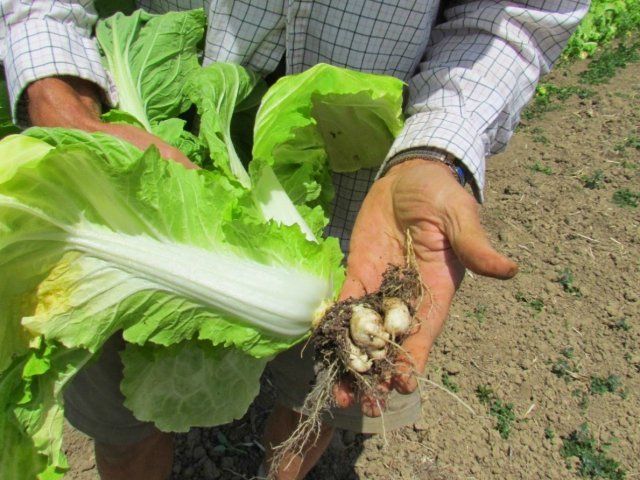

For the prevention of keela, seeds are disinfected before sowing.
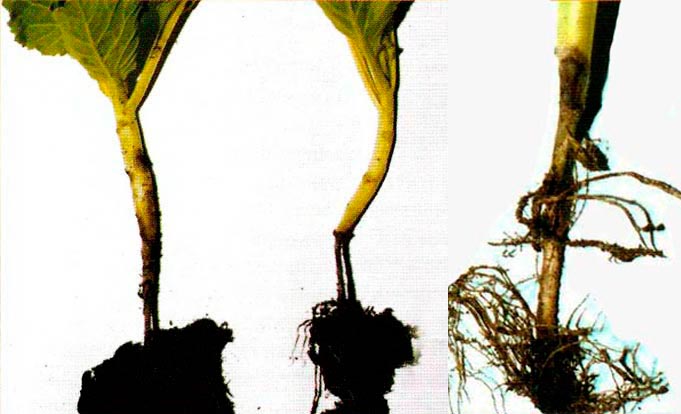

Black leg appears due to excessive watering and in prolonged rainy weather
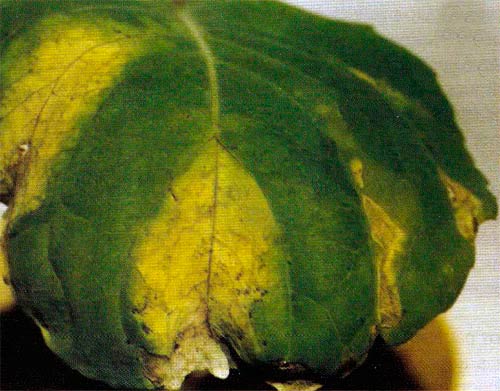

Downy mildew or downy mildew can kill the entire crop
Important! Before using various drugs, be sure to read the instructions!
Peking cabbage pests:
- Mole. A miniature butterfly 1.5 cm in size, a greenish caterpillar and a pupa are all different developmental cycles of the same pest, the cabbage moth. The female moth can lay 80–350 eggs, after 37 days caterpillars will appear from them, which penetrate the leaves, making passages in them. In just 2 weeks, the caterpillar turns into a pupa, after another 2 weeks the pupa becomes a butterfly and everything starts all over again. To scare away cabbage moths, you can sow calendula or marigolds next to cabbage.If this did not help and the moth started up, then it is necessary to treat the plants with drugs against pests.
- Cabbage or cruciferous flea beetle is a small bug 2-3 mm in size, sucking juices from cabbage leaves. To prevent the appearance of fleas, plants can be pollinated with tobacco or road dust, and when they appear, they can be treated with approved insecticides.
- Aphids are small, as if covered with whitish dust, sucking insects. They infect cabbage, completely covering the leaves, which subsequently discolor, curl, the development of the head of cabbage is suspended. When a small number of insects appear, cabbage leaves can be wiped off with a cloth dipped in a soap solution, and then sprayed with tobacco broth. If the moment is missed and the aphids have spread, the use of insecticides is allowed.
Photo gallery: who "eats" cabbage
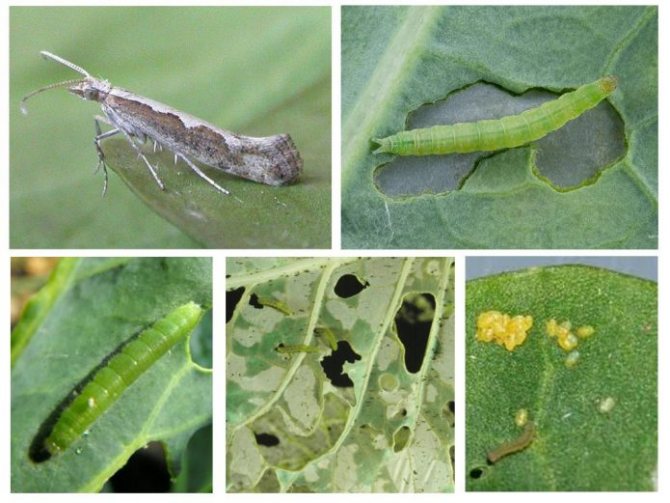

Cabbage moth caterpillars can eat heads of cabbage in a matter of days
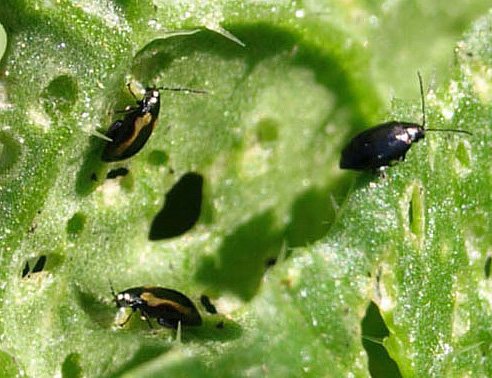

The cruciferous flea gives several generations per season, which can completely destroy the crop.


Cabbage aphid infects cabbage by sucking the juice from the leaves.
Since Peking cabbage is an early ripening culture, preparations with a short waiting period are suitable as pest control:
- Decis Profi (deltamethrin). During the growing season, cabbage is sprayed with a working solution (0.3 g / 5 l of water) against cabbage and turnip whites, cabbage scoops, fleas, aphids. The waiting period is 20 days.
- Spark M (malathion), emulsion concentrate. At a concentration of 10 ml / 10 l of water, it is allowed to spray cabbage against a complex of pests. The waiting period is 20 days.
The waiting period indicates how long after spraying the cabbage can be safely eaten.
As an alternative to pest control chemistry, there are several folk remedies:
- Vinegar. Its pungent smell repels many pests. To prepare a solution, 25 ml of vinegar essence is diluted in 10 liters of water.
- Ammonia. All insect pests do not like a specific smell: aphids, flies, bears, whites, slugs. 50 ml of alcohol (1 bottle) is diluted in 10 liters of water.
- A decoction of onion peels with the addition of garlic and laundry soap will scare away aphids. Brew 2 handfuls of onion peels with 1 liter of water, after the broth has cooled, add chopped head of garlic, 50 g of soap, leave for a day, then strain and bring the volume of liquid to 10 liters.
- To scare away slugs and snails, dust the ground around the cabbage with a mixture of ash, red or black peppers and dry mustard.
Treatments against insects are carried out by spraying plants in dry, calm weather.
Even plants love cabbage. One of these parasitic plants is the broomrape. Its roots have changed into suckers, with which it sticks to the cabbage roots, taking away all the nutrients from the cabbage, due to which it exists. Broomrape control measures are reduced to the timely removal of the weed.
Seed preparation
The germination capacity of cabbage seeds lasts for 3-4 years. If you use seeds of your own production, then before sowing them you need to prepare them:
- sort out non-emerging (for this, place a small portion of seeds in a weak - 3-5% - solution of table salt, mix gently, wait 10-15 minutes and send the seeds that have floated to the surface in the trash);
- disinfect them by placing them in water with a temperature of 48-50 ° C for 15–20 minutes;
- keep them in cool water for 1-2 minutes;
- dry on a paper towel until flowing;
- mix seeds with a little sand or small sawdust.
Before planting, keep the seeds in water and harden them at a temperature of 1-2 ° C for 24 hours. This will make them resistant to low temperatures and increase germination.
Store planting material does not need to be sorted and disinfected. There are seeds that do not even need preliminary soaking - they can be sown dry (they are usually colored).
You can read more about growing seedlings in our article.
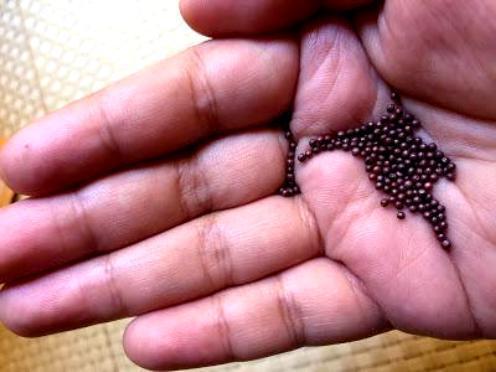

Seeds
Peking cabbage seed prices
Chinese cabbage seeds
Fertilizing
Peking cabbage needs to be fed with fertilizers, since the plant prefers soil rich in trace elements necessary for nutrition. For feeding, it is advisable to use a minimum of artificial fertilizers due to the plant's ability to quickly absorb all the "chemistry".
An example of dressing is:
- Manure or compost mixed with superphosphate - 3 kg per 1 tbsp.
- Manure with wood ash - 3 kg per 1.5 tbsp.
- Potassium sulfate - 2 tbsp. l. for 1 sq.m.
Herbal infusions can also be used.
Nettle infusion is a good growth stimulant, increases plant immunity. It is prepared for 2 weeks as follows: nettle is finely chopped in a bowl and poured with warm water in a ratio of 1:10. Due to its high concentration, the ready-made solution is mixed with water in a ratio of 40 to 60. After that, it can be applied to the soil.
Similarly, infusions of plantain, dandelion, coltsfoot are prepared.
Health benefits and harms
Thanks to a variety of useful microelements, Peking cabbage is indicated for the prevention of such diseases:
- Migraine;
- Circulatory disorders;
- Gastrointestinal disorders;
- Asthenia;
- Neurosis;
- Hypertension or hypotension.
Two main mistakes when growing Chinese cabbage:
Thanks to the fiber contained in kimchi, the peristalsis of the digestive organs is normalized, toxins and toxins are removed from the body. In addition, Chinese cabbage is an excellent dietary product due to its low calorie content (up to 140 kcal / kg).
Contraindications to the use of Peking cabbage:
- Peptic ulcer;
- Pancreatitis;
- Gastritis.
Also, this vegetable is not recommended for people suffering from high acidity of the stomach - the citric acid contained in cabbage can provoke heartburn.
Garden bed preparation
Peking loves loose (loamy), well-drained and nutrient-rich soils with a slightly acidic environment (a suitable soil solution pH is 5.5–7 units). An overly acidic environment disrupts nitrogen nutrition, which is important for the plant.
The note! If the acidity of the soil is increased, they resort to liming. This needs to be taken care of in the fall and dolomite flour or lime should be added to the soil during digging. If the soil is too salty, plow straw or sawdust into it when preparing the bed.
The soil should contain enough humus, since cabbage needs a lot of nutrients to grow. Fertilize the soil with compost (add a bucket of compost per 1 sq. M.). In the autumn, green manures are planted on the garden bed and buried; in the spring, the soil is again dug up and harrowed.
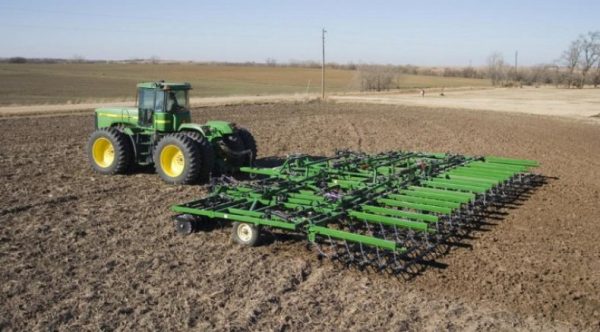

Harrowing the soil
It is advisable to comply with the agrotechnical requirements for planting. Avoid growing Chinese cabbage after other cruciferous plants to reduce the likelihood of crop death from insect pests. It is better to plant a Peking after cucumbers, garlic, carrots, legumes, onions or zucchini. These plants do not have common diseases and pests and leave behind a well-fertilized, nutritious soil.
The note! Choose green manures carefully for the soil. Since Peking is a member of the cruciferous family, do not use mustard for green manure. Phacelia is the best option.
How to care for a Beijing greenhouse?
To grow Chinese cabbage in a greenhouse, you need to prepare a nutritious, loose soil with a neutral pH, diffused lighting and the ability to shade the windows, reducing daylight hours.
Sowing is carried out in March, seedlings are grown in rows using the belt method. With increased density, the seedlings are thinned out, removing weak and elongated sprouts. Watering, feeding and other care is carried out in accordance with the general rules for growing crops.
If you follow all the recommendations, you can grow a generous harvest of cabbage with a rich vitamin composition and delicate, tasty leaves, suitable for universal culinary use.
How to properly plant a Peking
Peking cabbage does not like picking, after which it gets sick and slows down its development.
My own experience has shown that in order to avoid the loss of time for its survival in the soil and to get a harvest earlier, it is advisable to sow the seeds in separate cups or peat tablets.
Sowing in peat tablets
Peat tablets contain all substances and growth stimulants necessary for a young plant. The size of the tablet depends on the seeding depth. For cabbage, choose those that in dry form have a diameter of at least 4 cm. Before sowing, they need to be well moistened, they will increase in volume, become soft and suitable for use. A cabbage seed is sown into each tablet to a depth of 1.5 cm.
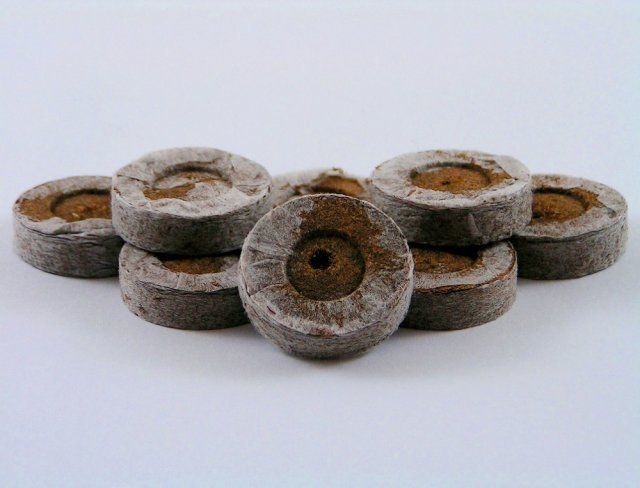

The tablets contain the entire supply of nutrients needed by the seedlings
Sowing in cups
Drainage holes must be made in plastic cups before sowing. This will prevent stagnant water and provide additional oxygen to the roots. It is best to make them not in the very bottom, but on the sides, below. Then the containers are filled with soil mixture, moistened and the seeds are sown. The planting depth is the same as for tablet seeding.
Seedling soil can be purchased at the store or prepared by yourself from 12 parts of peat, 4 parts of garden soil and 1 part of sand.
Sowing is carried out in two terms, the first in late March - early April, the second in early July. Cups or tablets are placed in the tray. The earth needs to be moistened periodically. Seedlings will appear in 4-6 days.
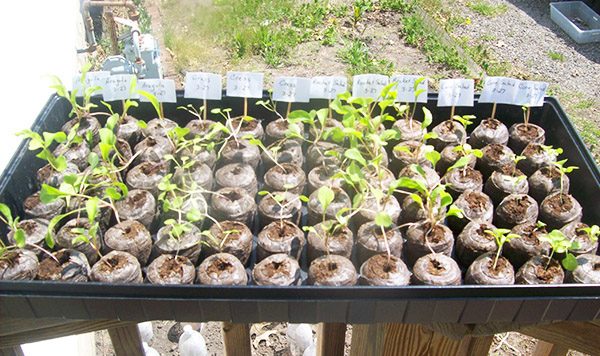

Cabbage seeds are sown to a depth of 1.5 cm, after a few days the first shoots will appear
Seedling care
Peking cabbage is a long day crop, an excess of light allows it to release arrows and obtain seeds. If the target is not seed, but heads of cabbage, then after the emergence of seedlings it needs to reduce daylight hours to 8-9 hours. For this purpose, any dark fabric that allows air to pass through is suitable. A mulching black non-woven fabric is also suitable. In the evening (at 17-18 o'clock) the seedlings are covered, and in the morning (at 8-9 o'clock) they are opened.
Caring for young plants is to reduce daylight hours, regular watering and adherence to temperature conditions. The optimum temperature for cabbage growth is 17–20 ° C. Water the plants as needed, preventing the earthen coma from drying out. After planting in open ground, it is necessary to cover the seedlings according to the same scheme, before setting the heads of cabbage. With this method, the cabbage is not threatened with shooting.
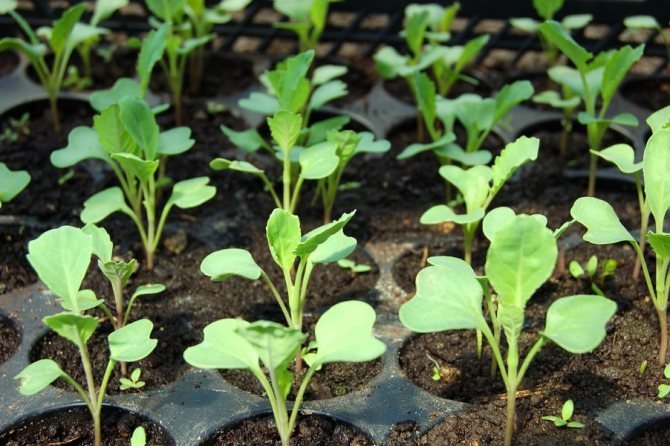

Peking cabbage needs 8-9 hours of daylight for normal growth.
Hardening
To protect the seedlings from sunburn and reduce stress between day and night temperature drops, it must be hardened before planting in the ground. Each gardener has his own hardening method.
I do this - 2 weeks before disembarkation, I take a box of seedlings outside every day. I leave the first 2 days for 15 minutes, then for 3 days I increase the time spent on the street to 30 minutes, on 6,7,8 days I leave for an hour, and then for the whole day. 3 days before disembarkation, I leave to spend the night on the street. Do not forget to water and cover. I plant seedlings in early May and early August at the age of 3-4 weeks. I carefully take out the seedlings from the cups together with the earthen lump, after watering it well, I plant the cabbage in tablets together with the tablets. It is not necessary to remove the tissue cover of the tablet, the roots easily pass through it, because it is rather thin and does not interfere with the growth of plants.
Watering
Any cabbage, including Peking cabbage, belongs to vegetables that are difficult to extract moisture, and consume extremely wastefully, so it needs abundant watering. People say: "To grow a head of cabbage, you need to spend a barrel of water."Water it with warm water and it will return a good harvest. Loosening and weeding as needed.


People say: "To grow a head of cabbage, you need to spend a barrel of water"
Top dressing
With excessive feeding, nitrates accumulate in vegetables, and Chinese cabbage is no exception. To prevent this from happening, you need to fertilize it in moderation, once every 2 weeks with an infusion of bird droppings or mullein. If the land has been well fertilized since the fall, then you can limit yourself to top dressing with herbal infusion.
Chicken manure is a valuable organic fertilizer with a rich chemical composition. This includes:
- vitamins,
- acids,
- phenols,
- sulfides,
- sulfur,
- cobalt,
- potassium,
- zinc.
To prepare the infusion, 1 kg of chicken manure must be poured with 10 liters of water, covered with a lid and left for 2 weeks for fermentation, stirring occasionally well. The result is a concentrated mother liquor. For feeding, 1 liter of mother liquor is diluted in 10 liters of water. The working solution is ready. Fertilize cabbage in the evening, after watering, pouring 1 liter under each root.
Mullein is an equally valuable organic fertilizer. The infusion is prepared and applied in the same way as for chicken. In the same way, you can prepare a combined infusion by mixing 0.5 kg of mullein and 0.5 kg of chicken manure.
Herbal infusion is an extract of nutrients obtained from common weeds. Weed grass takes from the ground the micro- and macroelements contained in it and partially accumulates them in itself. During the fermentation of plant residues in water, all these substances are released and pass into the liquid, enriching it. To prepare a useful extract, you must:
- Fill the barrel 1/3 with any weed and add water a little short of the top.
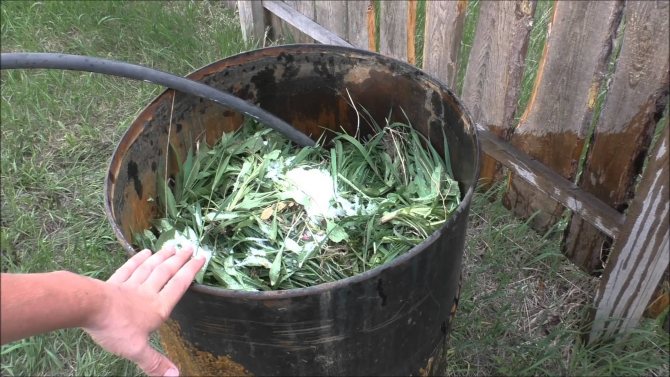

To prepare an infusion for feeding, you need to fill the barrel with weeds - Cover with breathable material.
- Insist for 2 weeks, stirring occasionally. The finished extract will turn brown.
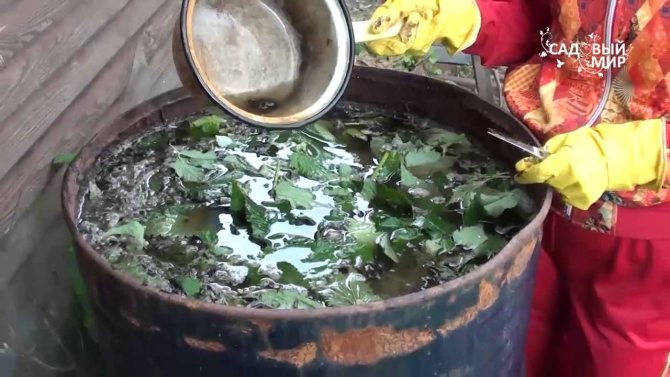

The feeding infusion will be ready in 2 weeks. - To prepare a working solution, 1 liter of the resulting infusion is filtered and diluted in 10 liters of water. For watering one plant, 1 liter of infusion is enough.
Some gardeners recommend covering the barrel with glass or film, I did not see a significant difference, except that the gas formed during fermentation evaporates faster through the breathable material.
Description of the plant
Peking cabbage (Brassica rapa L. subsp. Pekinensis), also called salad or petsai, is a subspecies of the Brassica family. Gardeners and summer residents love to grow it because of its high dietary value and taste. The vegetable contains many vitamins (especially a large amount of C) and mineral salts.


Cabbage is consumed in any form - raw, boiled, pickled, fried or stewed. Cultivation is characterized by high yield, short growing season (about 2-3 months) and the possibility of relatively long storage. The vegetable forms an oval-shaped head, the leaves are wide, wrinkled, streaked, wavy from the edge.
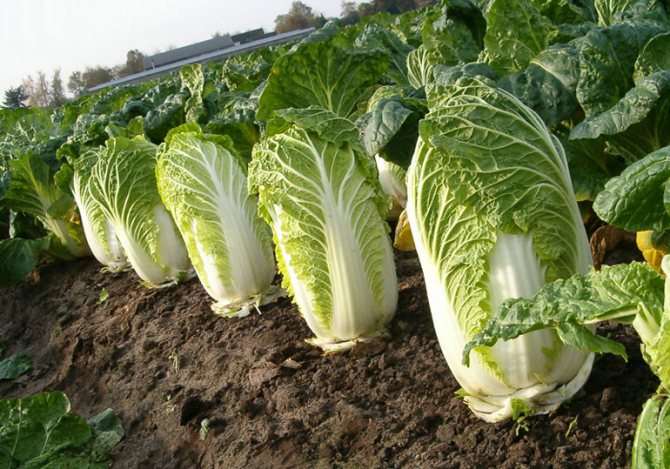

This plant has a short growing season, so it can be grown in the second harvest in the fall after harvesting early vegetables. Best growing conditions:
- correct temperature,
- short day.
The late cabbage harvest is suitable for long-term storage.
What can you plant after
After growing Peking cabbage in the open field, the site can be used for planting other crops.
However, not all plants will do well after kale. It is best to plant one of these types:
- tomatoes;
- cucumbers;
- beet;
- carrot;
- onion;
- garlic.
It is not difficult to understand how to grow Chinese cabbage properly.


Compliance with simple rules will allow you to get a harvest of fresh and healthy heads of cabbage, regardless of the region of the country.
CherryLink plugin not found
Growing technology and care
Fertilizer
Due to its short growing season and shallow root system, Peking is considered a vegetable with high requirements, especially in terms of nitrogen and potassium.
Chinese cabbage reacts very well to fertilization with manure, which is applied in the fall at a dose of 40 tons per hectare (400 kg per hundred square meters).
Mineral fertilizers should be applied deliberately, preferably based on a chemical analysis of the soil, so as not to over-fertilize the plants. The norms for the content of minerals in the soil are given above in the paragraph "soil requirements". Peking is a vegetable that can be fed with chloride or sulfate forms of fertilizers, because it is a neutral vegetable in relation to chlorine and sulfur compounds.
Soil deoxidation with lime is carried out during the year preceding cultivation, and only in exceptional cases can it be done in the spring using calcium carbonate CaCO₃. Calcium carbonate is also recommended for magnesium-poor soils.
On the other hand, acidification of the soil at a pH above 8 can be carried out before sowing using organic fertilizers - sour peat, compost bark from conifers or mineral preparations, for example, ammonium sulfate, which, in addition to acidification, will also enrich the soil with nitrogen.
Approximate application rates of nutrients for Chinese cabbage
| Battery | Application rate, kg | |
| Per hectare | For 1 are | |
| nitrogen | 100-150 | 1-1,5 |
| phosphorus P2O5 | 80-100 | 0,8-1 |
| potassium K2O | 160-200 | 1,6-2 |
Nitrogen fertilizers are applied before sowing or planting in an amount of about 2/3 of the recommended dose, and the remaining part is added to top dressing 2-2.5 weeks after sowing seeds or planting.
Shelter with agrofibre
When growing cabbage for an early spring harvest, you can use agrofibre weighing from 17 to 30 g / m². It will protect cabbage from wind and cold temperatures, especially in the first stage of growth, when the seedlings are most sensitive. This will speed up the maturation of the plants by several days and increase their yield. Agrotextile practically eliminates the infection of the Peking by pests, to a large extent prevents the knocking out of inflorescences.
Agrofibre is removed from plants 1-2 weeks before harvesting. Removing the cover will accelerate the growth of weeds and should be removed systematically.
Watering
During a drought, cabbage needs irrigation (a single dose of 5-10 mm - 500-1000 liters per hundred square meters), watering is carried out every 3-4 days. Peking's weak root system is the reason why cabbage requires a stable, relatively constant level of moisture.
Consequences of improper irrigation:
- Too little water will lead to premature development of peduncles, and in extreme cases, simply drying out of plants.
- Lack of water can cause not only inhibition of growth, but also a decrease in yield and a deterioration in the quality of the crop, the death of the border of leaves.
- Excessive watering can lead to weaker growth of cabbage, the development of diseases.
It is better to water the cabbage as needed, but in smaller doses and more often than in large doses and less often. Portions that are too large can cause rapid weed development and, in extreme cases (especially when the soil is poorly permeable), unfavorable anaerobic conditions.
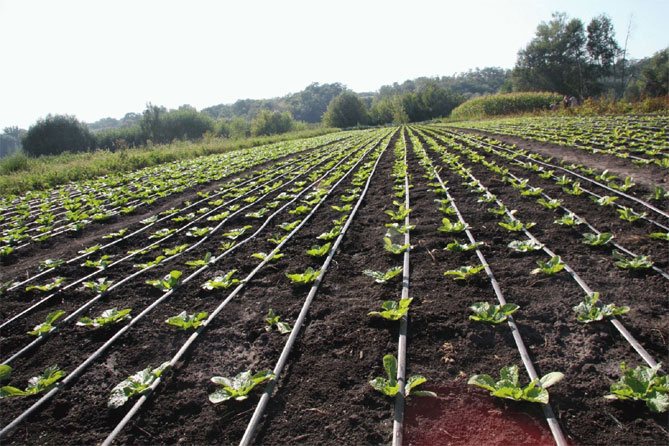

Weeding, plant protection
Overgrowth of weeds and lack of light can lead to significant yield losses and poor head quality. Weeds are especially dangerous during dry periods. Therefore, an important procedure is weeding (manual or mechanical, without the use of herbicides).
It is important to take into account that Peking has a shallow root system, so you should take care not to disturb the roots and not knock cabbage heads when weeding.
Because this plant has a particularly short growing season, chemical weed control using herbicides is not recommended. For the same reasons, plant protection products should be used with caution, choosing products with a short waiting period.
Mulching
It is advisable to carry out mulching, creating stable moisture conditions for good growth. Inorganic materials can be used - agrotextile. In this case, it is best to grow cabbage from seedlings. Agrotextile is spread before planting, and then cabbage seedlings are planted in the appropriate holes. Organic materials (straw, bark) are also good.
Mulching is also beneficial for cabbage because it is sensitive to weed growth. This technique will reduce the spread of weeds and save a lot of time to eliminate them, increasing yields.
Collection and storage
Cabbage is usually harvested gradually. Peking is ready for harvesting after the heads have ripened. In the case of spring cultivation, the cabbage must be harvested at the right time before the flower stalks begin to develop, preferably even before the heads are completely twisted. In fall harvests, you can wait until the heads are fully formed. Heads of cabbage are cut low above the ground.
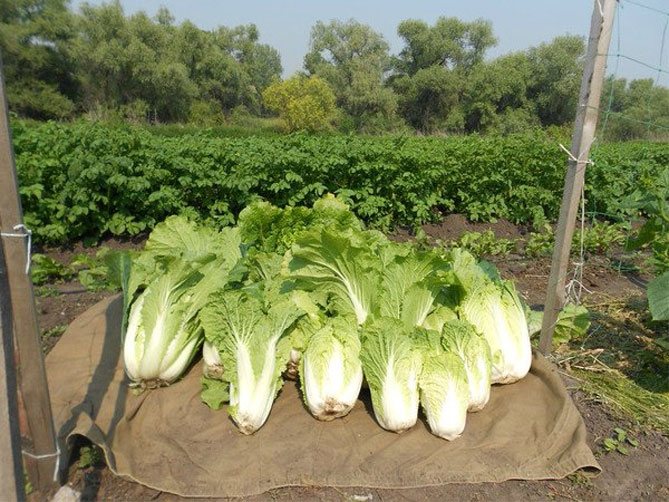

Cabbage harvested in spring is intended for consumption in the near future, autumn varieties are intended for storage from 2 to 6 months. The shelf life of Beijing depends on:
- varieties,
- growing conditions,
- the degree of maturity of the heads during harvest,
- conditions in the refrigerator.
Optimum conditions in cold rooms:
- temperature - 0-3 ° C,
- relative air humidity - 95-98%.
The storage temperature depends on the planned storage time and grade. It is worth remembering that at 0 ° C, some varieties are more susceptible to cold damage.
Conditions for growing cabbage
In addition to the established deadlines for the successful cultivation of cabbage, the presence of additional accompanying factors is necessary:
- the air temperature should be approximately + 13-20 degrees Celsius - it is then that the life process of the plant is activated. Sprouts can appear at +5 degrees, however, at the early stage of the growing season, it is optimal to keep seedlings at a temperature of 18 degrees Celsius, slightly lowering the temperature during the formation of heads of cabbage (to avoid flowering);
- air humidity should be within 70% on cloudy days and 80% on clear;
- the soil at the time of planting must fully ripen, that is, reach a temperature of at least 10 degrees, be loose, nutritious and always moist. Its optimum humidity in early spring is achieved by the presence of snow water. The optimum humidity is 65%.
Chinese cabbage pests, who are they?
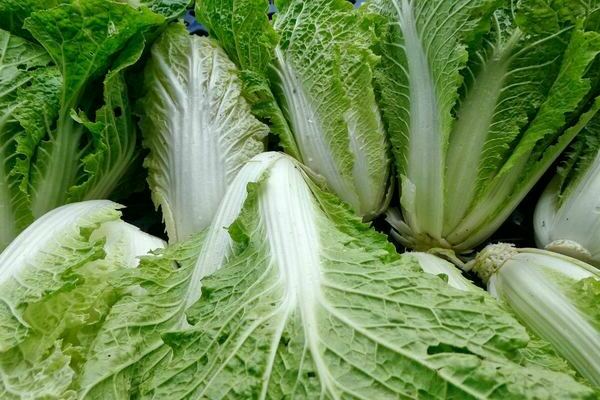

The nastiest of them are cruciferous fleas and slugs. Since Chinese cabbage is eaten fresh, and it ripens quickly enough, it is not recommended to process it with pesticides. The best option is to use folk remedies.
And the main thing is prevention:
1) Competent crop rotation (we use land for planting, where there were no crucifers).
2) Observe the landing time (see above).
3) We use covering devices that protect against harmful insects.
4) We use ash (wood or stove), or a lot of soot. Powder the ground with them at the time of emergence.
We must not forget to dig up the soil (we do not break the clods): then the frost will beat the harmful larvae.
A necessary preventive measure against harmful insects is joint planting with crops such as cucumbers, tomatoes, onions and garlic.
If you still need to use an insecticide, then this should be done no later than 25 days before picking cabbage. But it is still better to first carry out the treatment with some biological preparation, for example, "Bitoxibacillin".
At night, the most slippery and fastest eater of Peking cabbage, the slug, can attack. This happens so quickly that it is impossible to immediately understand what happened to the kachanas. You can fight these slippery creatures in different ways. Let's talk only about the most popular methods.
1) Place planks, pieces of slate, plastic or roofing felt on the surface of the ground where the culture grows.Late at night, having already eaten enough, all these living creatures will seek refuge and hide under all your prepared plates.
In the morning, by opening the shelters, you can remove all accumulated pests.
2) An original and very effective option is to mix wood ash (300 g) and hot pepper (1 tablespoon). Sprinkle over heads of cabbage before rain or watering. For this recipe of struggle, one time is not enough, the procedure must be repeated.
3) Dilute ordinary pharmacy brilliant green (1 bottle) with water and water the culture (1 bucket / 5m2).
Description
Peking cabbage (from Lat. Pekinensis) is a type of turnip, large densely accreted leaves of which form a loose oblong head of cabbage. The leaves have a characteristic appearance: tender, juicy, with a wavy edge and a pimpled middle. Peking cabbage heads have external similarities to lettuce, which is why it is often called Chinese salad.
This culture has a balanced composition, including vitamins of groups B, C, E, K, as well as proteins, fats, carbohydrates and a large amount of fiber.
Boarding time
Table 2. Planting time. Seedless method
| Spring period (for warm regions) | end of March - beginning of April |
| Spring-summer period | late April - mid June |
| Summer-autumn period | mid-July - mid-August |
Table 3. Landing time. Seedling method
| Spring period | the end of March |
| Summer period | end of June |
Growing methods
Peking cabbage is obtained by seedling and without seedlings (seeds). Check out the right growing technology to pay off your efforts.
Also find out when to harvest Brussels sprouts.
Seedling method
The advantage of this method is to accelerate growth and reduce ripening times. Let's immediately clarify the topical question, is it possible to dive a culture. Since Pekingka responds negatively to diving and takes a long time to adapt to a permanent place, it is preferable to grow it in separate pots or peat tablets.
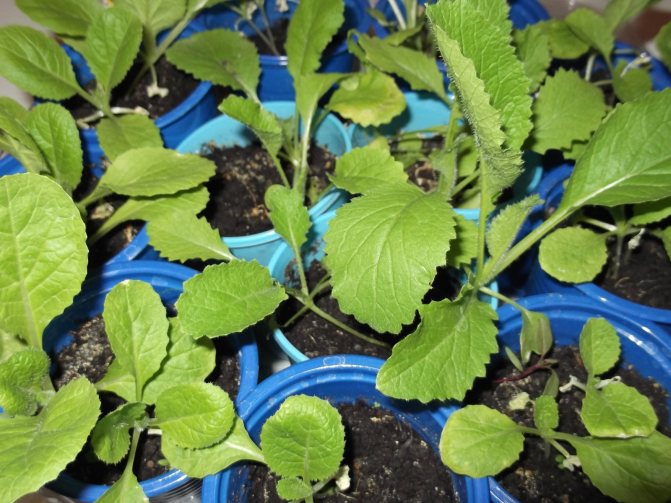

The soil should be light, non-acidic and rich in nutrients. Use humus mixed with coconut substrate (1: 2); a mixture of turf and peat in equal quantities is also suitable.
Consider the planting process in stages:
- Sow seeds in a container with soil mixture to a depth of 0.5–1 cm. Leave the pots in a dark, warm room.
- After 2-3 days, when the seedlings appear, take the pots out into the light.
- Irrigate seedlings only when the soil surface dries up. Watering should be stopped 3-4 days before planting on the site.
- When the seedlings have 4–5 true leaves (after about a month), they must be transplanted to a permanent place in the garden.
Seedless method
Next, consider how to plant an Asian beauty without seedlings. This technology can only be used in well-lit areas where potatoes, carrots, cucumbers, onions or garlic were previously grown. Regarding the temperature at which the seeds can be sown, keep in mind that the seed germinates already at 4 degrees above zero.


Plant as follows:
- At a distance of 25–30 cm from one another, form grooves (a similar distance is required between the rows in the garden).
- Add 0.5 liters of compost or humus to each groove, 2 tbsp. l of ash, then moisten the wells well.
- Plant the seeds 1–2 cm deep.
- Sprinkle ash on top and cover the plantings with a covering material or film. The first shoots will appear after 4-6 days.
Important! Peking cabbage can also be grown from sprouted stumps. But this is not the easiest method. In addition, when using this method, hybrid varieties will be able to give a good harvest only in the first year.
Growing by seeds
The seedless method avoids the plant transplant step, which simplifies the cultivation of Peking cabbage.Seeds are usually planted in open ground for a late harvest - for the autumn-winter use of heads of cabbage.
Planting dates for Chinese cabbage
The timing of planting Chinese cabbage depends on the climatic characteristics of the regions and weather conditions. Sowing begins as soon as the soil warms up.
When choosing the timing of sowing, the time of the appearance of the first frosts and the ripening time of the variety are taken into account. If, for example, the first frosts appear in early September, then the late varieties will not have time to ripen. But in the southern regions, you can easily grow late-ripening varieties.
For direct sowing of seeds into the ground, three seeding times are recommended:
- April 25-May 5;
- May 20-June 1;
- at the beginning of August.
In June and until mid-July, the vegetable is not sown - such plantings develop flowering. The optimum temperature for the development of the Peking is from +16 to + 22 ° C. Table 2 shows the timing of sowing seeds for different cultivation methods (for regions with a temperate climate).
table 2
| Growing method | Early maturing varieties | Mid-season | Late ripening |
| Seedling | mid-March to mid-April | early April | do not sit |
| Sowing in open ground | May | May | end of July - first decade of August |
| Sowing in greenhouse soil | April | April | mid august |
Planting scheme
When sowing Peking cabbage directly into the ground, accuracy is needed - the seeds are immediately distributed in their holes. The distances between adjacent grooves depend on the variety:
- for early varieties - the interval between adjacent holes is 30-40 cm;
- for late varieties - 45-50 cm.
If the planting for some reason turned out to be too frequent - perhaps the gardener wanted to play it safe and sowed the seeds too often, they will have to be thinned out.
Early-maturing leafy varieties are sown at intervals of 10 cm. When the leaves appear on the plants, they are cut off for salads - space is freed up for other plants.
Sowing seeds in the ground
Sowing procedure in open ground:
- On prepared beds - dug up and fertilized, markings are made in accordance with the planting scheme.
- Sowing can be done in two ways - in the made furrows or in single holes. The best option is to make a small comb, and in it - holes with an interval of 25-30 cm. The seeds are sown into the furrow denser - at a distance of 10 cm. All excess shoots are then removed.
- Several seeds are placed in each hole - 2-3 pieces are enough. Planting depth - 1.5 cm.
- The planted seeds are sprinkled with soil, and slightly compacted with the palm of your hand.
- After a couple of weeks, the seedlings are thinned out, leaving the best sprout.
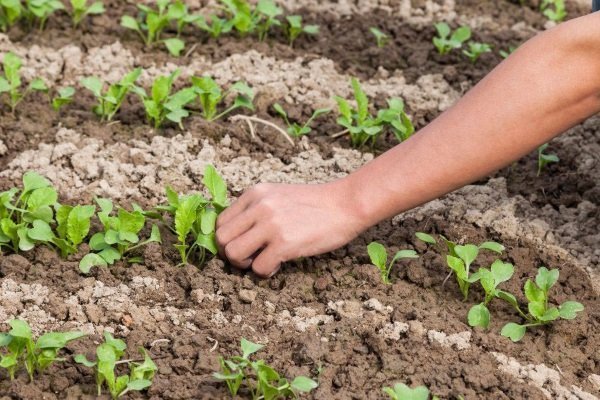

Experienced gardeners advise covering the sprouts with plastic bottles with open lids - so that cabbage, cruciferous flea and slugs do not pounce on tender seedlings.
How to properly prepare planting material
If the cabbage seeds are purchased, then they do not need to be cooked in a special way for planting. They do not need to be soaked in water before planting. If the seeds are collected with your own hands, then they must first be germinated. It is possible that some of them will not rise. For germination, the planting material is laid out on a moistened gauze. The fabric is needed in several layers. After that, you need to wait until the seeds germinate. To do this, they need from three to five days. If the seeds of Chinese cabbage have not sprouted, then you need to buy others.
Popular: What care daylilies need for long and lush flowering
Popular bugs
The most common mistakes gardeners make:
- Incorrectly chosen time of sowing seeds leads to flowering. A similar effect is caused by the wrong timing of transplanting. Those who doubt the success are advised to use hybrids - their shooting is less developed.
- If the plantings are too dense, the plant does not receive proper nutrition and space for growth - this leads to flowering of part of the crops. To prevent this situation, it is necessary to observe the planting intervals and thin out the plants as needed.
- When the seedlings are transplanted into cold soil, the plants stop growing. As a result, they do not have time to mature, while they often throw out the arrows.
- The intense heat also promotes shooting. If the temperature rises above + 22 ° C, you should not be too lazy to create artificial shading for plantings by throwing a special canvas on them.
- If the cabbage is not removed in time, it will bloom.
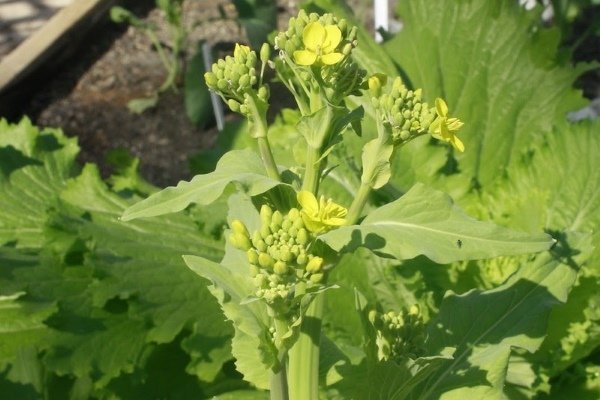

Flowering Chinese cabbage
Requirements for soil and climate
Chinese cabbage can be grown successfully in many regions, but it requires optimal conditions, especially in terms of:
- temperature,
- humidity,
- soil quality,
- the content of minerals in the soil.
Soil requirements
The optimum soil pH is 6.5-7.0. If the pH is too low, the risk of infestation of the kale plants increases, especially in the case of inadequate crop rotation.
Due to the poorly developed root system, Peking grows better on fertile and humus soils. Peat soils with a pH level of 6.5-6.8 are suitable. Successful cultivation on light soils requires fertilization with a large amount of manure.
1 dm³ of soil should contain:
| Battery | Content, mg |
| nitrogen | 100-130 |
| phosphorus | 50-60 |
| potassium | 160-200 |
| magnesium | 55-65 |
| calcium | 1000-1500 |
Climatic requirements
An important parameter for growing cabbage is temperature. The temperature and length of the day have a significant impact on the growth and development of Peking. Although after head formation the cabbage does a good job of intermittent frosts down to 4 degrees Celsius below zero, it is necessary to maintain a minimum temperature of 16 degrees during germination and an optimum temperature of about 21 degrees Celsius during growth.
It is necessary to protect the heads of cabbage from the effects of the wind. A weak root system and significant and rapid weight gain can create problems. Large heads can fall due to the influence of not only wind, but also heavy precipitation.
It is better to choose sunny positions for cabbage, but she also likes partial shade.


Crop rotation and predecessors
When growing lettuce, you should follow the rules of crop rotation.
- Cabbage has a high nitrogen requirement and should be planted after plants with low nutritional requirements.
- The vegetable belongs to the Cabbage family, so it can be grown after other plants in this family no more often than every 4 years. Growing Peking after beets and spinach should also be avoided due to the potential for the spread of beet nematodes.
- Peking is a leafy plant, so it is best to plant it after root crops.
Good Precursors for Peking Cabbage:
- legumes: peas, beans, beans, vetch, peas;
- potatoes;
- tomatoes;
- cucumbers, pumpkin, melon;
- celery;
- onions, garlic, leeks;
- chicory, phacelia.
Chinese cabbage is very keel-susceptible, so it should not be grown in the same spot each year or after other cabbage vegetables.
Testimonials
★★★★★
Vasily Yegorovich, amateur gardener, Lipetsk region. I grow Peking in a greenhouse. At first I tried to grow it in the usual way - in the open field. But she did not take root well, then the heads of cabbage released arrows and bloomed. Now I grow in a greenhouse - there are no problems with shooting here. I plant different varieties - mostly early ones.
★★★★★
Polina Sh., 45 years old, Krasnodar region. I like Victoria the most. Its heads of cabbage are perfectly stored, moreover, in winter they become even tastier. She has very juicy leaves - perfect for salads. It grows best in a greenhouse, but for me it matures well in the open field, the main thing is to cover the seedlings with foil after planting.
There are several important nuances in the cultivation of Chinese cabbage. The main condition for obtaining a harvest is timely sowing of seeds. It is worth confusing the timing, and instead of juicy heads of cabbage, you get a flowering plant.The rest of the "Peking" agrotechnics does not stand out in any way - every gardener can grow this vegetable.
0
Diseases and treatments
Peking cabbage is not only attacked by pests, but also infected with dangerous diseases. Among them: Bacterial rot. Rotting spots with an unpleasant odor appear on the leaves. At the first symptoms of the disease, a special agent "Binoram" is used. Powdery mildew (real and false). Young plants are most often infected with false dew, adult Peking cabbage is less likely to get sick with it. For seedlings and adults, infection means death. With a disease, blurry gray spots appear on the leaves. At the first sign of downy mildew, the seedlings can be treated with wood ash. Re-processing is carried out in a week.
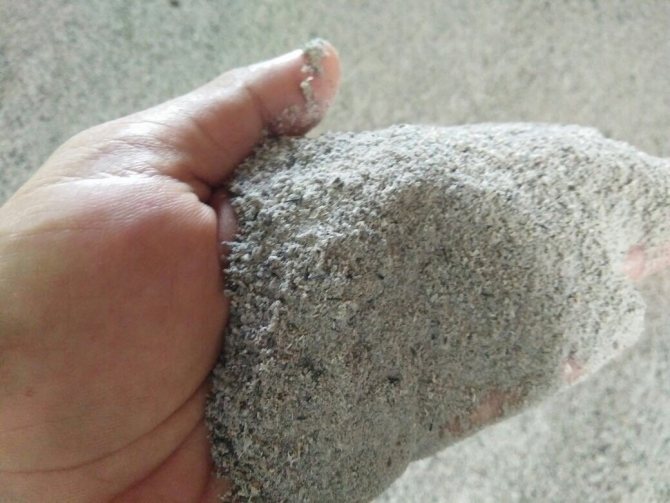

Leaf spot - The disease is caused by a fungal infection. It affects not only the plants in the beds, but also the heads of cabbage that have already been plucked. Manifestation of the disease: black spots on cabbage leaves. Preventive measures are carried out before sowing: the seeds are processed, and the remnants of last year's crops must be removed from the beds. Vascular bacteriosis. Able to hit Chinese cabbage at any stage of cultivation. The leaves turn yellow, the veins turn black. The seedlings die, the crop deteriorates. Get rid of infected bushes and heads of cabbage.
The main attention is paid to prevention: pre-sowing treatment of seeds and cleaning the beds from fragments of old plants. Necrosis is a non-communicable disease caused by improper growing conditions. It appears as dark dots on the leaves on the inside of the head of cabbage. The disease is usually caused by high levels of phosphorus and nitrogen in the soil. Black leg This disease, which is caused by a fungus, affects seedlings and seeds during the germination process. Treatment does not always end favorably, so it is better to take care of prevention in advance.
Waterlogging and oversaturation of the soil with nitrogen should be avoided. "Black leg" is actively developing at low temperatures and insufficient illumination. Young plants should not be cramped in containers or in the garden.
If it was not possible to avoid the disease, the infected plants are removed, and with them the soil in which they grew. Healthy specimens are sprayed with a fungicide (Fitosporin-M, Bordeaux liquid, Previcur Energy). The earth is loosened and sand and ash are added to it. Disease prevention begins with the purchase of quality seeds, with their processing, after which they acquire resistance to various negative influences. And also with the disinfection of soil mixture.


